Why are social networks more persuasive than traditional word-of-mouth?
VerifiedAdded on 2023/06/03
|21
|4749
|132
AI Summary
This study uses a mixed-method approach to gather data on the impact of social networks and traditional word-of-mouth on consumer behavior and to develop a conceptual framework for understanding the factors that influence the effectiveness of WOM in different contexts.
Contribute Materials
Your contribution can guide someone’s learning journey. Share your
documents today.
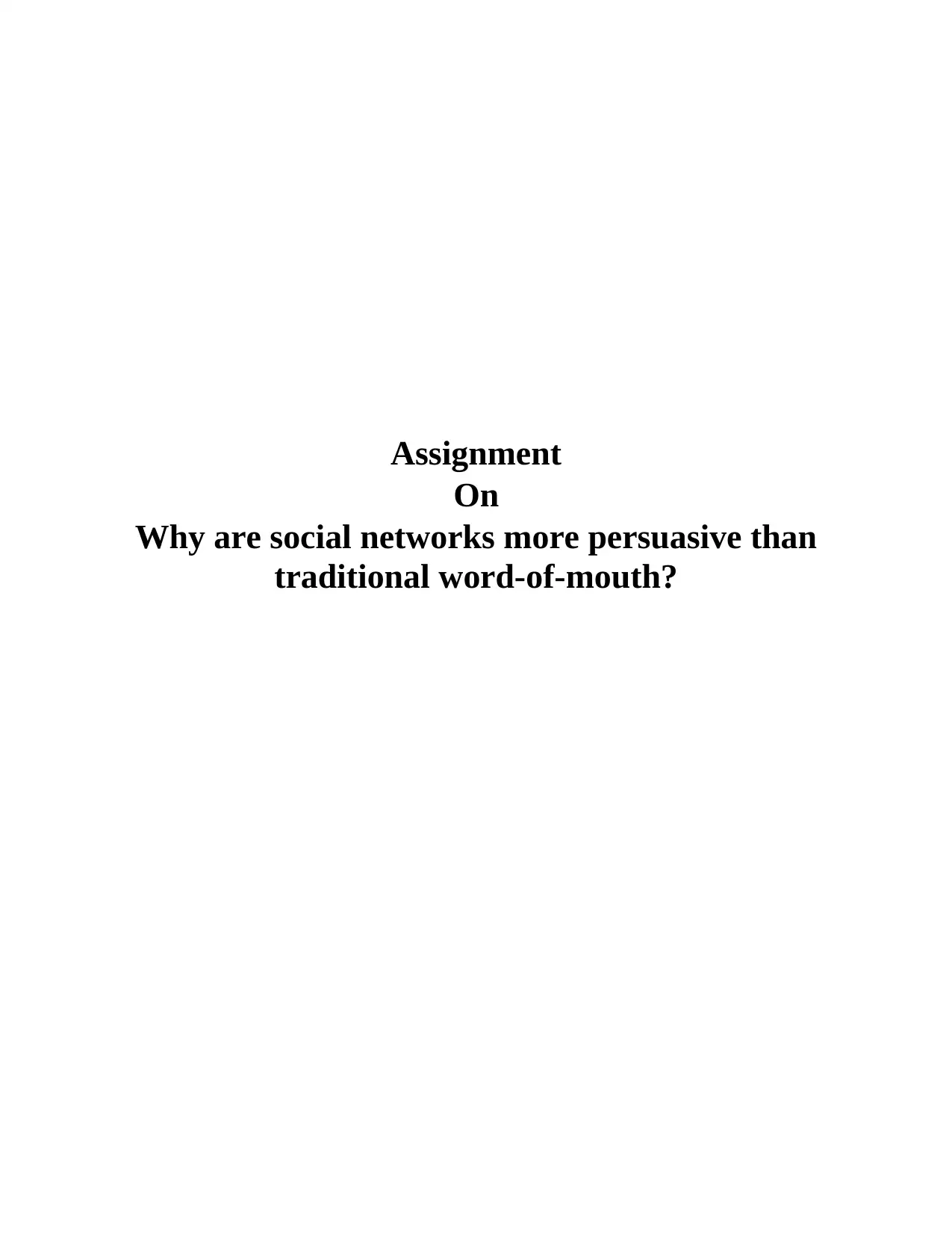
Assignment
On
Why are social networks more persuasive than
traditional word-of-mouth?
On
Why are social networks more persuasive than
traditional word-of-mouth?
Secure Best Marks with AI Grader
Need help grading? Try our AI Grader for instant feedback on your assignments.
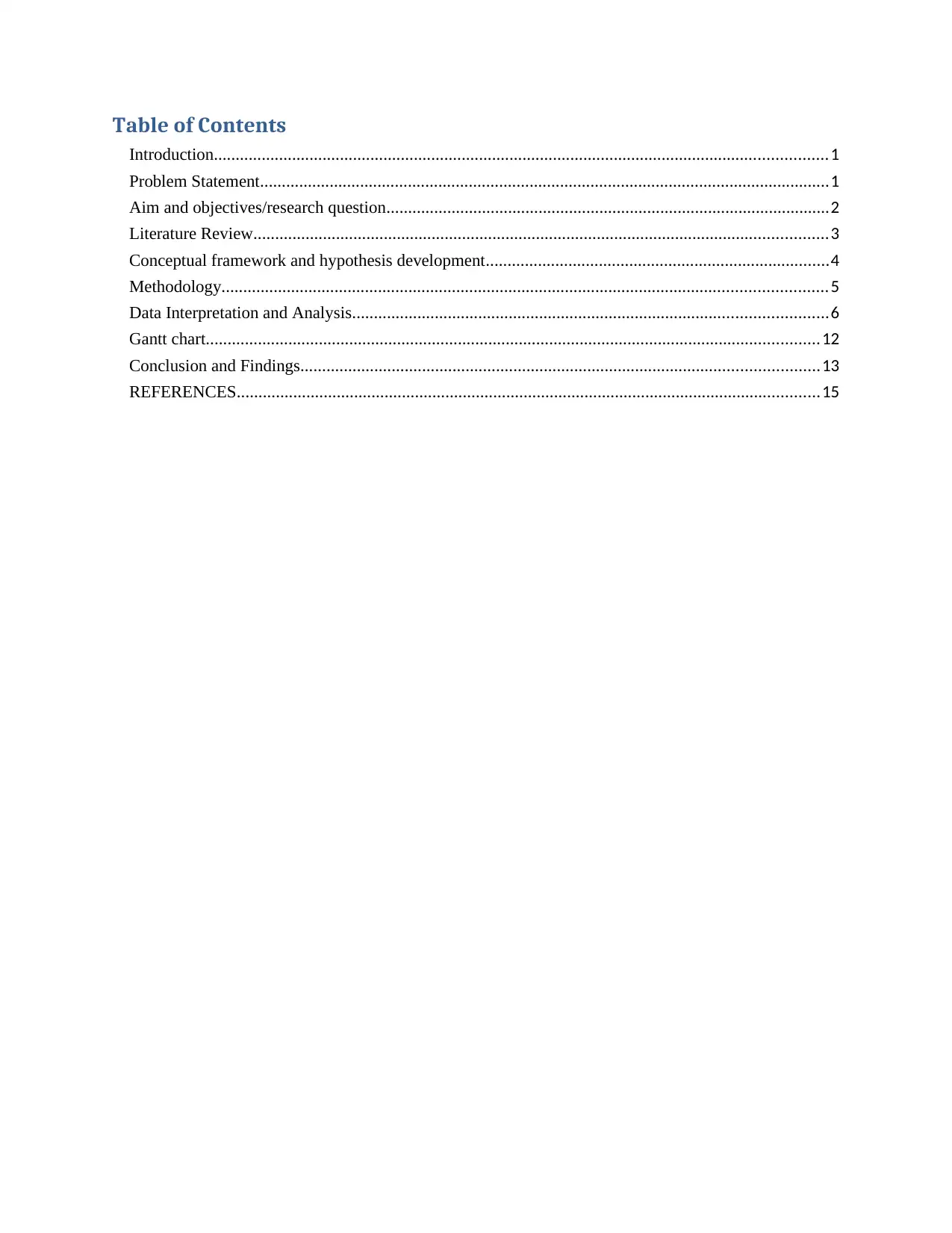
Table of Contents
Introduction.............................................................................................................................................1
Problem Statement...................................................................................................................................1
Aim and objectives/research question......................................................................................................2
Literature Review....................................................................................................................................3
Conceptual framework and hypothesis development...............................................................................4
Methodology...........................................................................................................................................5
Data Interpretation and Analysis.............................................................................................................6
Gantt chart.............................................................................................................................................12
Conclusion and Findings.......................................................................................................................13
REFERENCES......................................................................................................................................15
Introduction.............................................................................................................................................1
Problem Statement...................................................................................................................................1
Aim and objectives/research question......................................................................................................2
Literature Review....................................................................................................................................3
Conceptual framework and hypothesis development...............................................................................4
Methodology...........................................................................................................................................5
Data Interpretation and Analysis.............................................................................................................6
Gantt chart.............................................................................................................................................12
Conclusion and Findings.......................................................................................................................13
REFERENCES......................................................................................................................................15
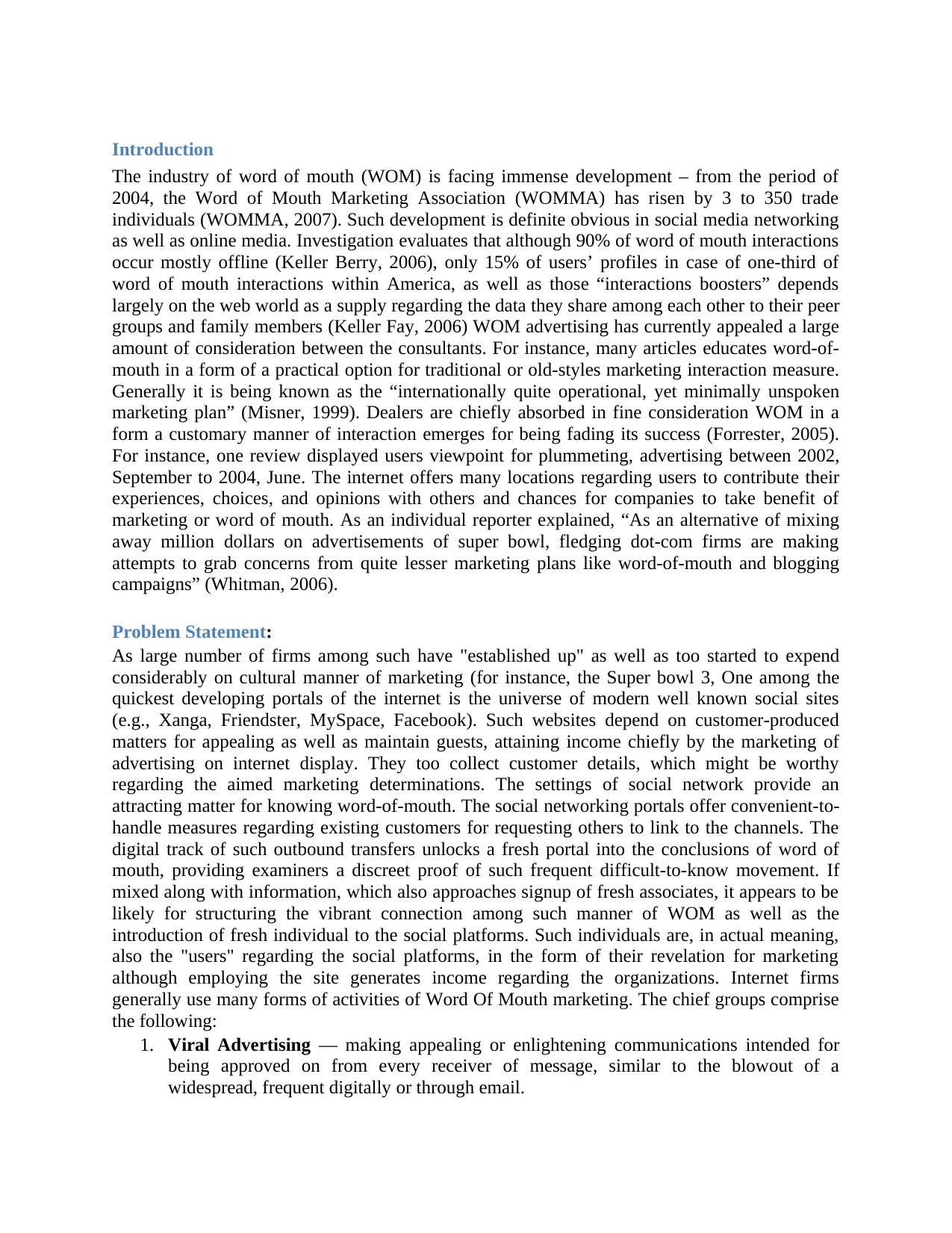
Introduction
The industry of word of mouth (WOM) is facing immense development – from the period of
2004, the Word of Mouth Marketing Association (WOMMA) has risen by 3 to 350 trade
individuals (WOMMA, 2007). Such development is definite obvious in social media networking
as well as online media. Investigation evaluates that although 90% of word of mouth interactions
occur mostly offline (Keller Berry, 2006), only 15% of users’ profiles in case of one-third of
word of mouth interactions within America, as well as those “interactions boosters” depends
largely on the web world as a supply regarding the data they share among each other to their peer
groups and family members (Keller Fay, 2006) WOM advertising has currently appealed a large
amount of consideration between the consultants. For instance, many articles educates word-of-
mouth in a form of a practical option for traditional or old-styles marketing interaction measure.
Generally it is being known as the “internationally quite operational, yet minimally unspoken
marketing plan” (Misner, 1999). Dealers are chiefly absorbed in fine consideration WOM in a
form a customary manner of interaction emerges for being fading its success (Forrester, 2005).
For instance, one review displayed users viewpoint for plummeting, advertising between 2002,
September to 2004, June. The internet offers many locations regarding users to contribute their
experiences, choices, and opinions with others and chances for companies to take benefit of
marketing or word of mouth. As an individual reporter explained, “As an alternative of mixing
away million dollars on advertisements of super bowl, fledging dot-com firms are making
attempts to grab concerns from quite lesser marketing plans like word-of-mouth and blogging
campaigns” (Whitman, 2006).
Problem Statement:
As large number of firms among such have "established up" as well as too started to expend
considerably on cultural manner of marketing (for instance, the Super bowl 3, One among the
quickest developing portals of the internet is the universe of modern well known social sites
(e.g., Xanga, Friendster, MySpace, Facebook). Such websites depend on customer-produced
matters for appealing as well as maintain guests, attaining income chiefly by the marketing of
advertising on internet display. They too collect customer details, which might be worthy
regarding the aimed marketing determinations. The settings of social network provide an
attracting matter for knowing word-of-mouth. The social networking portals offer convenient-to-
handle measures regarding existing customers for requesting others to link to the channels. The
digital track of such outbound transfers unlocks a fresh portal into the conclusions of word of
mouth, providing examiners a discreet proof of such frequent difficult-to-know movement. If
mixed along with information, which also approaches signup of fresh associates, it appears to be
likely for structuring the vibrant connection among such manner of WOM as well as the
introduction of fresh individual to the social platforms. Such individuals are, in actual meaning,
also the "users" regarding the social platforms, in the form of their revelation for marketing
although employing the site generates income regarding the organizations. Internet firms
generally use many forms of activities of Word Of Mouth marketing. The chief groups comprise
the following:
1. Viral Advertising — making appealing or enlightening communications intended for
being approved on from every receiver of message, similar to the blowout of a
widespread, frequent digitally or through email.
The industry of word of mouth (WOM) is facing immense development – from the period of
2004, the Word of Mouth Marketing Association (WOMMA) has risen by 3 to 350 trade
individuals (WOMMA, 2007). Such development is definite obvious in social media networking
as well as online media. Investigation evaluates that although 90% of word of mouth interactions
occur mostly offline (Keller Berry, 2006), only 15% of users’ profiles in case of one-third of
word of mouth interactions within America, as well as those “interactions boosters” depends
largely on the web world as a supply regarding the data they share among each other to their peer
groups and family members (Keller Fay, 2006) WOM advertising has currently appealed a large
amount of consideration between the consultants. For instance, many articles educates word-of-
mouth in a form of a practical option for traditional or old-styles marketing interaction measure.
Generally it is being known as the “internationally quite operational, yet minimally unspoken
marketing plan” (Misner, 1999). Dealers are chiefly absorbed in fine consideration WOM in a
form a customary manner of interaction emerges for being fading its success (Forrester, 2005).
For instance, one review displayed users viewpoint for plummeting, advertising between 2002,
September to 2004, June. The internet offers many locations regarding users to contribute their
experiences, choices, and opinions with others and chances for companies to take benefit of
marketing or word of mouth. As an individual reporter explained, “As an alternative of mixing
away million dollars on advertisements of super bowl, fledging dot-com firms are making
attempts to grab concerns from quite lesser marketing plans like word-of-mouth and blogging
campaigns” (Whitman, 2006).
Problem Statement:
As large number of firms among such have "established up" as well as too started to expend
considerably on cultural manner of marketing (for instance, the Super bowl 3, One among the
quickest developing portals of the internet is the universe of modern well known social sites
(e.g., Xanga, Friendster, MySpace, Facebook). Such websites depend on customer-produced
matters for appealing as well as maintain guests, attaining income chiefly by the marketing of
advertising on internet display. They too collect customer details, which might be worthy
regarding the aimed marketing determinations. The settings of social network provide an
attracting matter for knowing word-of-mouth. The social networking portals offer convenient-to-
handle measures regarding existing customers for requesting others to link to the channels. The
digital track of such outbound transfers unlocks a fresh portal into the conclusions of word of
mouth, providing examiners a discreet proof of such frequent difficult-to-know movement. If
mixed along with information, which also approaches signup of fresh associates, it appears to be
likely for structuring the vibrant connection among such manner of WOM as well as the
introduction of fresh individual to the social platforms. Such individuals are, in actual meaning,
also the "users" regarding the social platforms, in the form of their revelation for marketing
although employing the site generates income regarding the organizations. Internet firms
generally use many forms of activities of Word Of Mouth marketing. The chief groups comprise
the following:
1. Viral Advertising — making appealing or enlightening communications intended for
being approved on from every receiver of message, similar to the blowout of a
widespread, frequent digitally or through email.
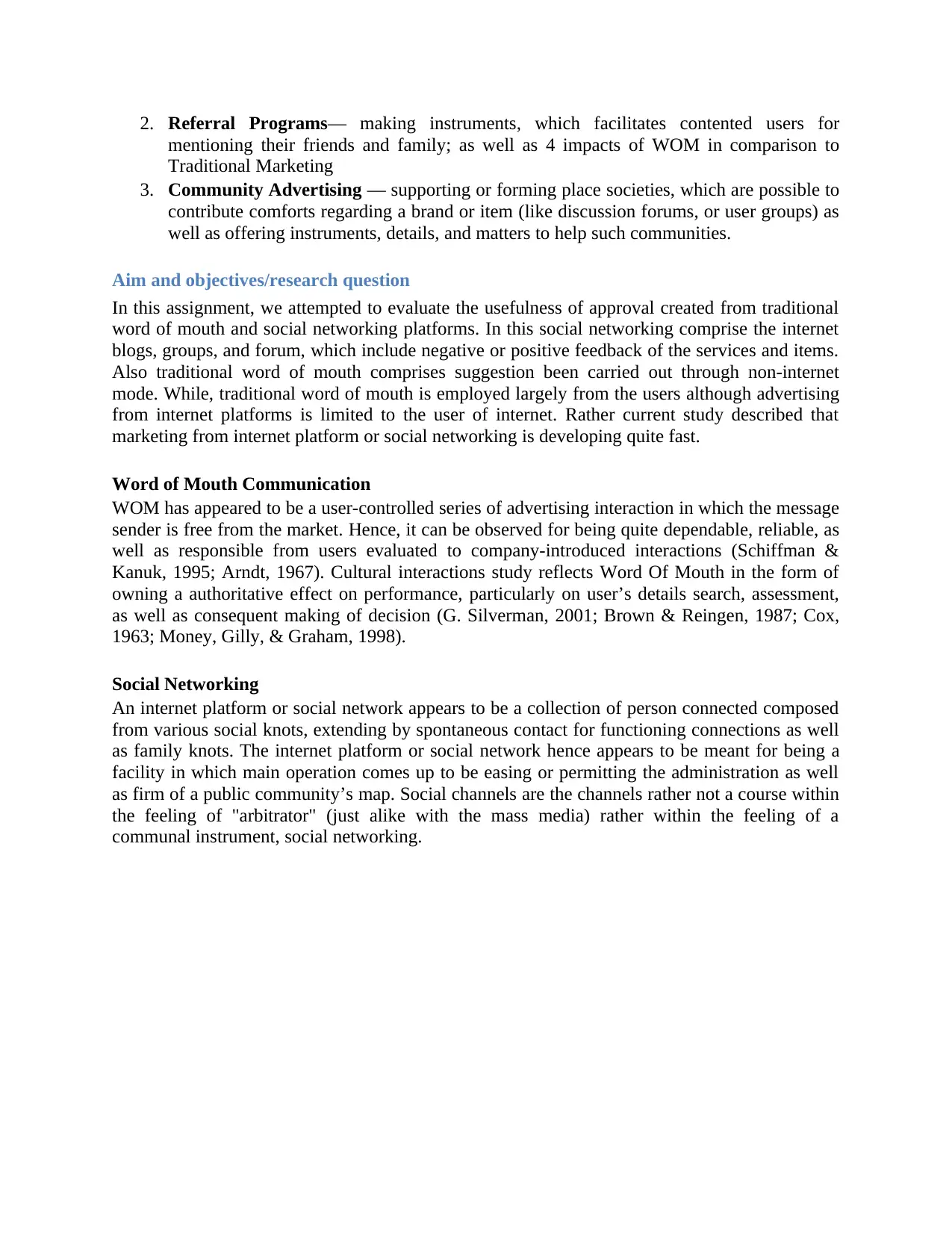
2. Referral Programs— making instruments, which facilitates contented users for
mentioning their friends and family; as well as 4 impacts of WOM in comparison to
Traditional Marketing
3. Community Advertising — supporting or forming place societies, which are possible to
contribute comforts regarding a brand or item (like discussion forums, or user groups) as
well as offering instruments, details, and matters to help such communities.
Aim and objectives/research question
In this assignment, we attempted to evaluate the usefulness of approval created from traditional
word of mouth and social networking platforms. In this social networking comprise the internet
blogs, groups, and forum, which include negative or positive feedback of the services and items.
Also traditional word of mouth comprises suggestion been carried out through non-internet
mode. While, traditional word of mouth is employed largely from the users although advertising
from internet platforms is limited to the user of internet. Rather current study described that
marketing from internet platform or social networking is developing quite fast.
Word of Mouth Communication
WOM has appeared to be a user-controlled series of advertising interaction in which the message
sender is free from the market. Hence, it can be observed for being quite dependable, reliable, as
well as responsible from users evaluated to company-introduced interactions (Schiffman &
Kanuk, 1995; Arndt, 1967). Cultural interactions study reflects Word Of Mouth in the form of
owning a authoritative effect on performance, particularly on user’s details search, assessment,
as well as consequent making of decision (G. Silverman, 2001; Brown & Reingen, 1987; Cox,
1963; Money, Gilly, & Graham, 1998).
Social Networking
An internet platform or social network appears to be a collection of person connected composed
from various social knots, extending by spontaneous contact for functioning connections as well
as family knots. The internet platform or social network hence appears to be meant for being a
facility in which main operation comes up to be easing or permitting the administration as well
as firm of a public community’s map. Social channels are the channels rather not a course within
the feeling of "arbitrator" (just alike with the mass media) rather within the feeling of a
communal instrument, social networking.
mentioning their friends and family; as well as 4 impacts of WOM in comparison to
Traditional Marketing
3. Community Advertising — supporting or forming place societies, which are possible to
contribute comforts regarding a brand or item (like discussion forums, or user groups) as
well as offering instruments, details, and matters to help such communities.
Aim and objectives/research question
In this assignment, we attempted to evaluate the usefulness of approval created from traditional
word of mouth and social networking platforms. In this social networking comprise the internet
blogs, groups, and forum, which include negative or positive feedback of the services and items.
Also traditional word of mouth comprises suggestion been carried out through non-internet
mode. While, traditional word of mouth is employed largely from the users although advertising
from internet platforms is limited to the user of internet. Rather current study described that
marketing from internet platform or social networking is developing quite fast.
Word of Mouth Communication
WOM has appeared to be a user-controlled series of advertising interaction in which the message
sender is free from the market. Hence, it can be observed for being quite dependable, reliable, as
well as responsible from users evaluated to company-introduced interactions (Schiffman &
Kanuk, 1995; Arndt, 1967). Cultural interactions study reflects Word Of Mouth in the form of
owning a authoritative effect on performance, particularly on user’s details search, assessment,
as well as consequent making of decision (G. Silverman, 2001; Brown & Reingen, 1987; Cox,
1963; Money, Gilly, & Graham, 1998).
Social Networking
An internet platform or social network appears to be a collection of person connected composed
from various social knots, extending by spontaneous contact for functioning connections as well
as family knots. The internet platform or social network hence appears to be meant for being a
facility in which main operation comes up to be easing or permitting the administration as well
as firm of a public community’s map. Social channels are the channels rather not a course within
the feeling of "arbitrator" (just alike with the mass media) rather within the feeling of a
communal instrument, social networking.
Secure Best Marks with AI Grader
Need help grading? Try our AI Grader for instant feedback on your assignments.
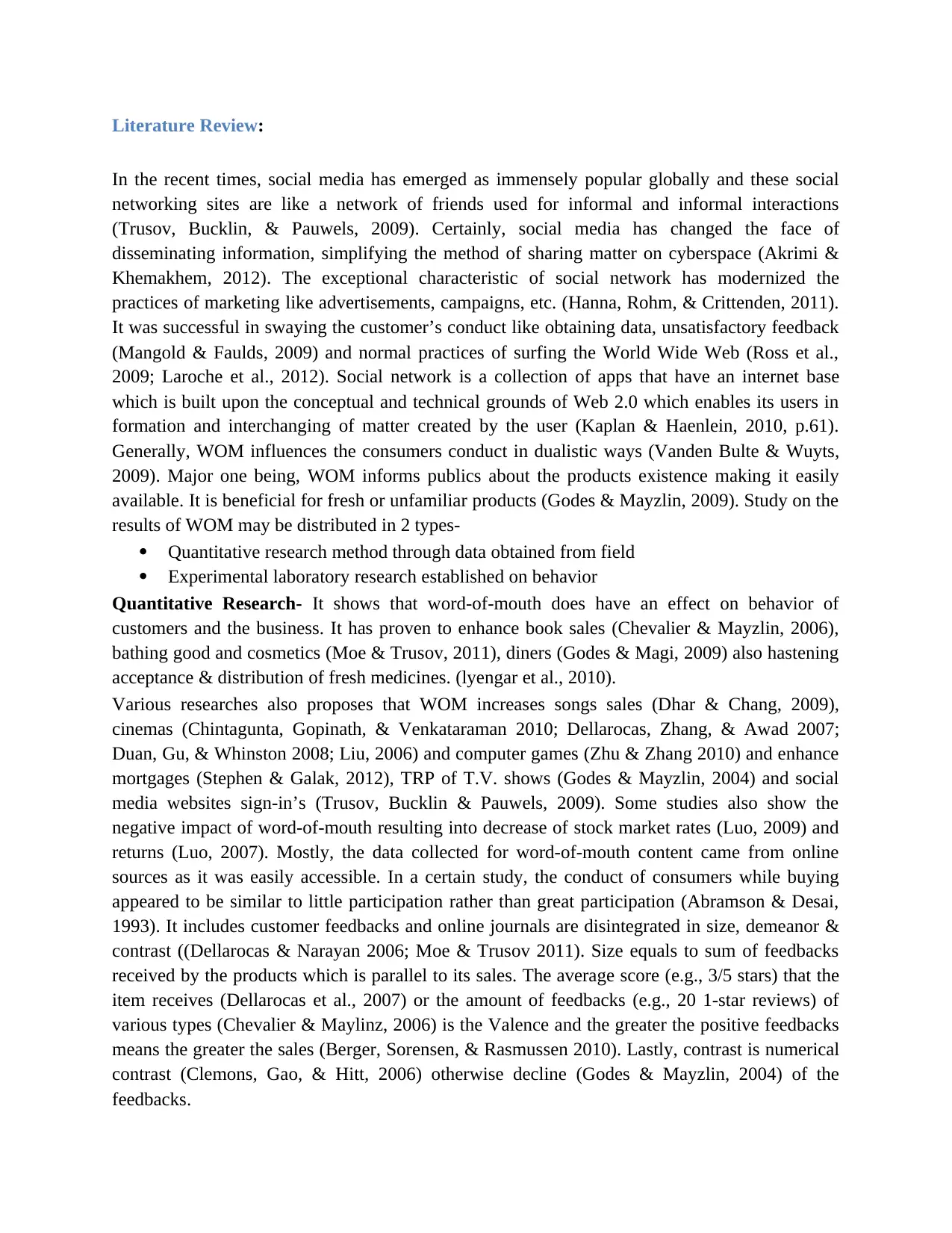
Literature Review:
In the recent times, social media has emerged as immensely popular globally and these social
networking sites are like a network of friends used for informal and informal interactions
(Trusov, Bucklin, & Pauwels, 2009). Certainly, social media has changed the face of
disseminating information, simplifying the method of sharing matter on cyberspace (Akrimi &
Khemakhem, 2012). The exceptional characteristic of social network has modernized the
practices of marketing like advertisements, campaigns, etc. (Hanna, Rohm, & Crittenden, 2011).
It was successful in swaying the customer’s conduct like obtaining data, unsatisfactory feedback
(Mangold & Faulds, 2009) and normal practices of surfing the World Wide Web (Ross et al.,
2009; Laroche et al., 2012). Social network is a collection of apps that have an internet base
which is built upon the conceptual and technical grounds of Web 2.0 which enables its users in
formation and interchanging of matter created by the user (Kaplan & Haenlein, 2010, p.61).
Generally, WOM influences the consumers conduct in dualistic ways (Vanden Bulte & Wuyts,
2009). Major one being, WOM informs publics about the products existence making it easily
available. It is beneficial for fresh or unfamiliar products (Godes & Mayzlin, 2009). Study on the
results of WOM may be distributed in 2 types-
Quantitative research method through data obtained from field
Experimental laboratory research established on behavior
Quantitative Research- It shows that word-of-mouth does have an effect on behavior of
customers and the business. It has proven to enhance book sales (Chevalier & Mayzlin, 2006),
bathing good and cosmetics (Moe & Trusov, 2011), diners (Godes & Magi, 2009) also hastening
acceptance & distribution of fresh medicines. (lyengar et al., 2010).
Various researches also proposes that WOM increases songs sales (Dhar & Chang, 2009),
cinemas (Chintagunta, Gopinath, & Venkataraman 2010; Dellarocas, Zhang, & Awad 2007;
Duan, Gu, & Whinston 2008; Liu, 2006) and computer games (Zhu & Zhang 2010) and enhance
mortgages (Stephen & Galak, 2012), TRP of T.V. shows (Godes & Mayzlin, 2004) and social
media websites sign-in’s (Trusov, Bucklin & Pauwels, 2009). Some studies also show the
negative impact of word-of-mouth resulting into decrease of stock market rates (Luo, 2009) and
returns (Luo, 2007). Mostly, the data collected for word-of-mouth content came from online
sources as it was easily accessible. In a certain study, the conduct of consumers while buying
appeared to be similar to little participation rather than great participation (Abramson & Desai,
1993). It includes customer feedbacks and online journals are disintegrated in size, demeanor &
contrast ((Dellarocas & Narayan 2006; Moe & Trusov 2011). Size equals to sum of feedbacks
received by the products which is parallel to its sales. The average score (e.g., 3/5 stars) that the
item receives (Dellarocas et al., 2007) or the amount of feedbacks (e.g., 20 1-star reviews) of
various types (Chevalier & Maylinz, 2006) is the Valence and the greater the positive feedbacks
means the greater the sales (Berger, Sorensen, & Rasmussen 2010). Lastly, contrast is numerical
contrast (Clemons, Gao, & Hitt, 2006) otherwise decline (Godes & Mayzlin, 2004) of the
feedbacks.
In the recent times, social media has emerged as immensely popular globally and these social
networking sites are like a network of friends used for informal and informal interactions
(Trusov, Bucklin, & Pauwels, 2009). Certainly, social media has changed the face of
disseminating information, simplifying the method of sharing matter on cyberspace (Akrimi &
Khemakhem, 2012). The exceptional characteristic of social network has modernized the
practices of marketing like advertisements, campaigns, etc. (Hanna, Rohm, & Crittenden, 2011).
It was successful in swaying the customer’s conduct like obtaining data, unsatisfactory feedback
(Mangold & Faulds, 2009) and normal practices of surfing the World Wide Web (Ross et al.,
2009; Laroche et al., 2012). Social network is a collection of apps that have an internet base
which is built upon the conceptual and technical grounds of Web 2.0 which enables its users in
formation and interchanging of matter created by the user (Kaplan & Haenlein, 2010, p.61).
Generally, WOM influences the consumers conduct in dualistic ways (Vanden Bulte & Wuyts,
2009). Major one being, WOM informs publics about the products existence making it easily
available. It is beneficial for fresh or unfamiliar products (Godes & Mayzlin, 2009). Study on the
results of WOM may be distributed in 2 types-
Quantitative research method through data obtained from field
Experimental laboratory research established on behavior
Quantitative Research- It shows that word-of-mouth does have an effect on behavior of
customers and the business. It has proven to enhance book sales (Chevalier & Mayzlin, 2006),
bathing good and cosmetics (Moe & Trusov, 2011), diners (Godes & Magi, 2009) also hastening
acceptance & distribution of fresh medicines. (lyengar et al., 2010).
Various researches also proposes that WOM increases songs sales (Dhar & Chang, 2009),
cinemas (Chintagunta, Gopinath, & Venkataraman 2010; Dellarocas, Zhang, & Awad 2007;
Duan, Gu, & Whinston 2008; Liu, 2006) and computer games (Zhu & Zhang 2010) and enhance
mortgages (Stephen & Galak, 2012), TRP of T.V. shows (Godes & Mayzlin, 2004) and social
media websites sign-in’s (Trusov, Bucklin & Pauwels, 2009). Some studies also show the
negative impact of word-of-mouth resulting into decrease of stock market rates (Luo, 2009) and
returns (Luo, 2007). Mostly, the data collected for word-of-mouth content came from online
sources as it was easily accessible. In a certain study, the conduct of consumers while buying
appeared to be similar to little participation rather than great participation (Abramson & Desai,
1993). It includes customer feedbacks and online journals are disintegrated in size, demeanor &
contrast ((Dellarocas & Narayan 2006; Moe & Trusov 2011). Size equals to sum of feedbacks
received by the products which is parallel to its sales. The average score (e.g., 3/5 stars) that the
item receives (Dellarocas et al., 2007) or the amount of feedbacks (e.g., 20 1-star reviews) of
various types (Chevalier & Maylinz, 2006) is the Valence and the greater the positive feedbacks
means the greater the sales (Berger, Sorensen, & Rasmussen 2010). Lastly, contrast is numerical
contrast (Clemons, Gao, & Hitt, 2006) otherwise decline (Godes & Mayzlin, 2004) of the
feedbacks.
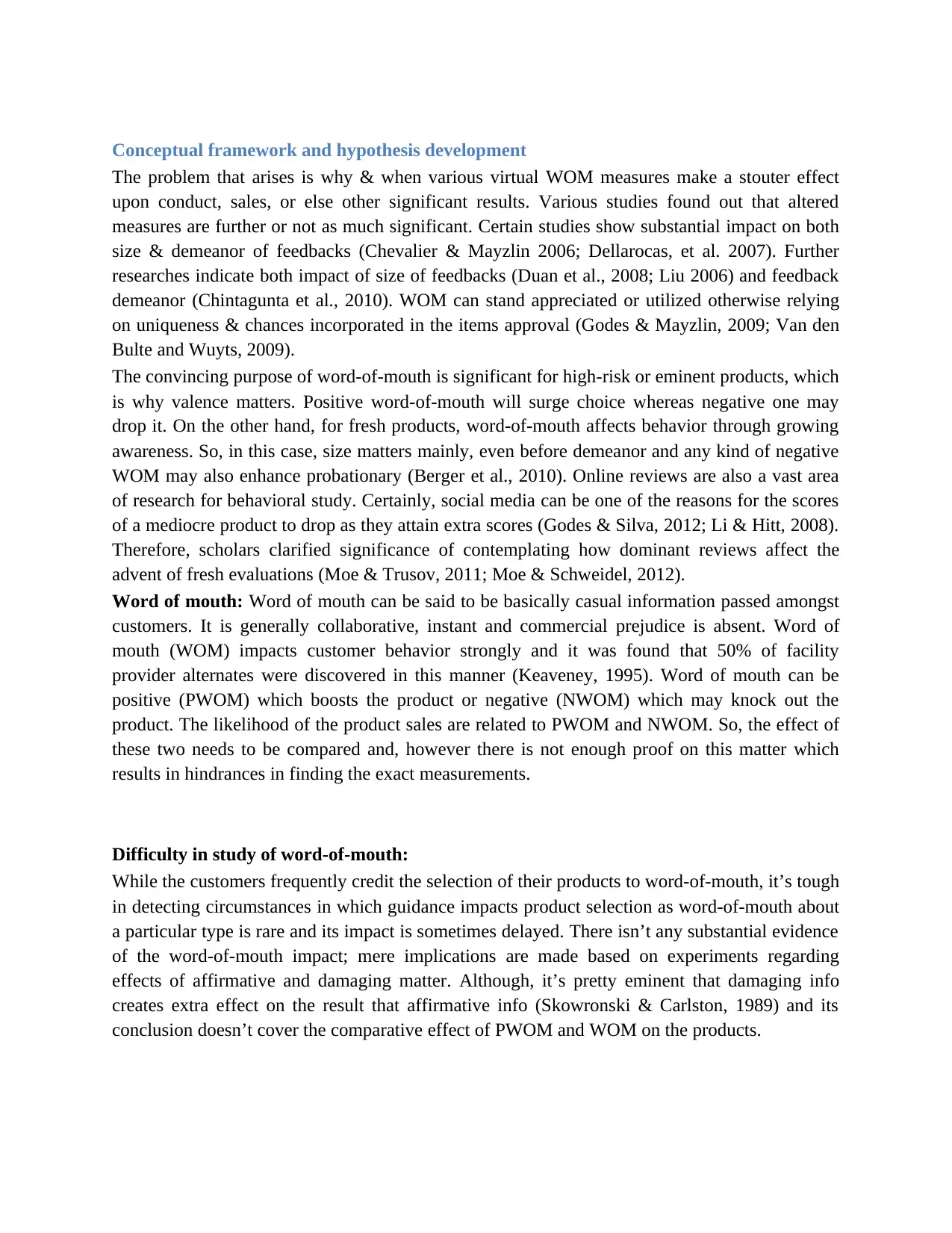
Conceptual framework and hypothesis development
The problem that arises is why & when various virtual WOM measures make a stouter effect
upon conduct, sales, or else other significant results. Various studies found out that altered
measures are further or not as much significant. Certain studies show substantial impact on both
size & demeanor of feedbacks (Chevalier & Mayzlin 2006; Dellarocas, et al. 2007). Further
researches indicate both impact of size of feedbacks (Duan et al., 2008; Liu 2006) and feedback
demeanor (Chintagunta et al., 2010). WOM can stand appreciated or utilized otherwise relying
on uniqueness & chances incorporated in the items approval (Godes & Mayzlin, 2009; Van den
Bulte and Wuyts, 2009).
The convincing purpose of word-of-mouth is significant for high-risk or eminent products, which
is why valence matters. Positive word-of-mouth will surge choice whereas negative one may
drop it. On the other hand, for fresh products, word-of-mouth affects behavior through growing
awareness. So, in this case, size matters mainly, even before demeanor and any kind of negative
WOM may also enhance probationary (Berger et al., 2010). Online reviews are also a vast area
of research for behavioral study. Certainly, social media can be one of the reasons for the scores
of a mediocre product to drop as they attain extra scores (Godes & Silva, 2012; Li & Hitt, 2008).
Therefore, scholars clarified significance of contemplating how dominant reviews affect the
advent of fresh evaluations (Moe & Trusov, 2011; Moe & Schweidel, 2012).
Word of mouth: Word of mouth can be said to be basically casual information passed amongst
customers. It is generally collaborative, instant and commercial prejudice is absent. Word of
mouth (WOM) impacts customer behavior strongly and it was found that 50% of facility
provider alternates were discovered in this manner (Keaveney, 1995). Word of mouth can be
positive (PWOM) which boosts the product or negative (NWOM) which may knock out the
product. The likelihood of the product sales are related to PWOM and NWOM. So, the effect of
these two needs to be compared and, however there is not enough proof on this matter which
results in hindrances in finding the exact measurements.
Difficulty in study of word-of-mouth:
While the customers frequently credit the selection of their products to word-of-mouth, it’s tough
in detecting circumstances in which guidance impacts product selection as word-of-mouth about
a particular type is rare and its impact is sometimes delayed. There isn’t any substantial evidence
of the word-of-mouth impact; mere implications are made based on experiments regarding
effects of affirmative and damaging matter. Although, it’s pretty eminent that damaging info
creates extra effect on the result that affirmative info (Skowronski & Carlston, 1989) and its
conclusion doesn’t cover the comparative effect of PWOM and WOM on the products.
The problem that arises is why & when various virtual WOM measures make a stouter effect
upon conduct, sales, or else other significant results. Various studies found out that altered
measures are further or not as much significant. Certain studies show substantial impact on both
size & demeanor of feedbacks (Chevalier & Mayzlin 2006; Dellarocas, et al. 2007). Further
researches indicate both impact of size of feedbacks (Duan et al., 2008; Liu 2006) and feedback
demeanor (Chintagunta et al., 2010). WOM can stand appreciated or utilized otherwise relying
on uniqueness & chances incorporated in the items approval (Godes & Mayzlin, 2009; Van den
Bulte and Wuyts, 2009).
The convincing purpose of word-of-mouth is significant for high-risk or eminent products, which
is why valence matters. Positive word-of-mouth will surge choice whereas negative one may
drop it. On the other hand, for fresh products, word-of-mouth affects behavior through growing
awareness. So, in this case, size matters mainly, even before demeanor and any kind of negative
WOM may also enhance probationary (Berger et al., 2010). Online reviews are also a vast area
of research for behavioral study. Certainly, social media can be one of the reasons for the scores
of a mediocre product to drop as they attain extra scores (Godes & Silva, 2012; Li & Hitt, 2008).
Therefore, scholars clarified significance of contemplating how dominant reviews affect the
advent of fresh evaluations (Moe & Trusov, 2011; Moe & Schweidel, 2012).
Word of mouth: Word of mouth can be said to be basically casual information passed amongst
customers. It is generally collaborative, instant and commercial prejudice is absent. Word of
mouth (WOM) impacts customer behavior strongly and it was found that 50% of facility
provider alternates were discovered in this manner (Keaveney, 1995). Word of mouth can be
positive (PWOM) which boosts the product or negative (NWOM) which may knock out the
product. The likelihood of the product sales are related to PWOM and NWOM. So, the effect of
these two needs to be compared and, however there is not enough proof on this matter which
results in hindrances in finding the exact measurements.
Difficulty in study of word-of-mouth:
While the customers frequently credit the selection of their products to word-of-mouth, it’s tough
in detecting circumstances in which guidance impacts product selection as word-of-mouth about
a particular type is rare and its impact is sometimes delayed. There isn’t any substantial evidence
of the word-of-mouth impact; mere implications are made based on experiments regarding
effects of affirmative and damaging matter. Although, it’s pretty eminent that damaging info
creates extra effect on the result that affirmative info (Skowronski & Carlston, 1989) and its
conclusion doesn’t cover the comparative effect of PWOM and WOM on the products.
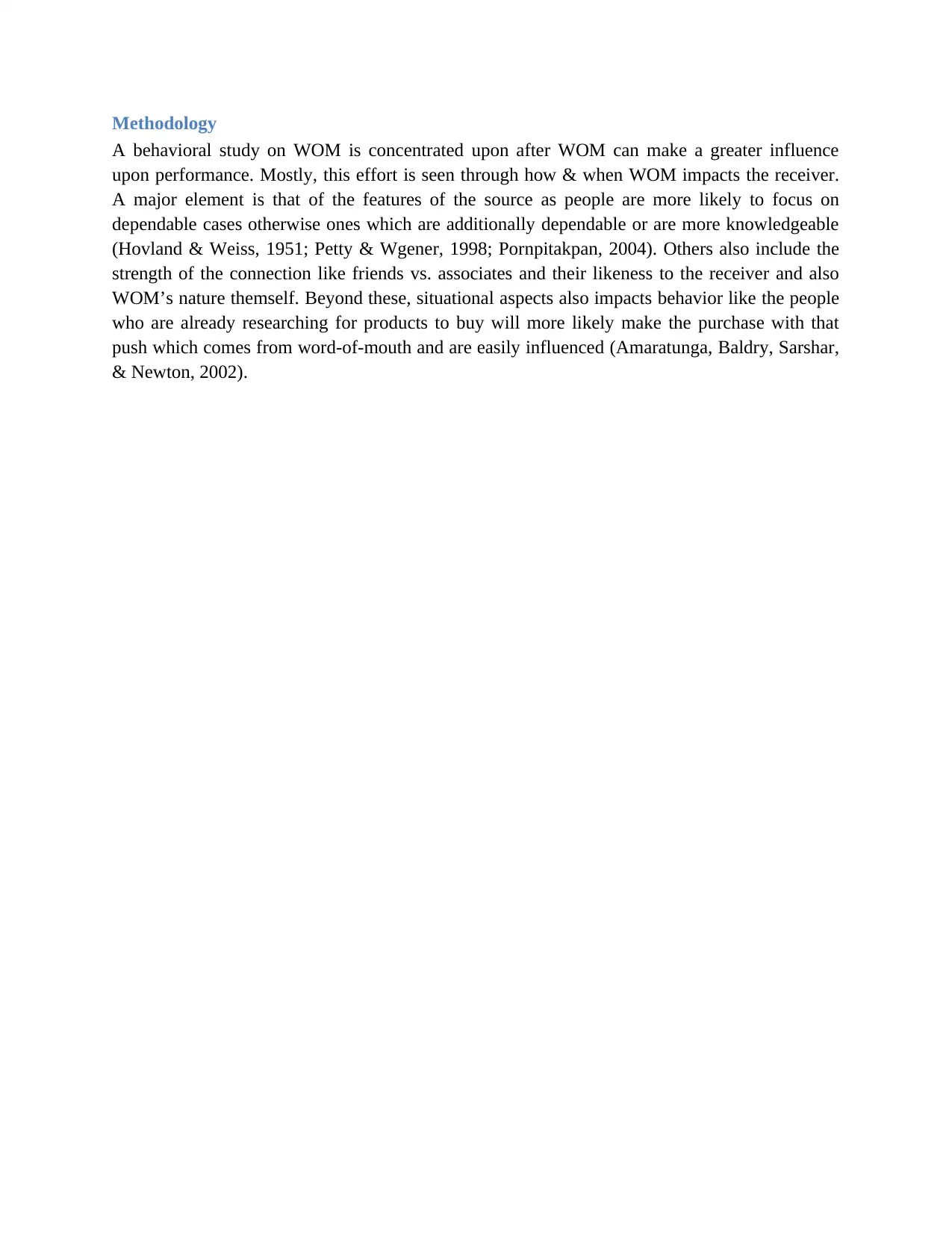
Methodology
A behavioral study on WOM is concentrated upon after WOM can make a greater influence
upon performance. Mostly, this effort is seen through how & when WOM impacts the receiver.
A major element is that of the features of the source as people are more likely to focus on
dependable cases otherwise ones which are additionally dependable or are more knowledgeable
(Hovland & Weiss, 1951; Petty & Wgener, 1998; Pornpitakpan, 2004). Others also include the
strength of the connection like friends vs. associates and their likeness to the receiver and also
WOM’s nature themself. Beyond these, situational aspects also impacts behavior like the people
who are already researching for products to buy will more likely make the purchase with that
push which comes from word-of-mouth and are easily influenced (Amaratunga, Baldry, Sarshar,
& Newton, 2002).
A behavioral study on WOM is concentrated upon after WOM can make a greater influence
upon performance. Mostly, this effort is seen through how & when WOM impacts the receiver.
A major element is that of the features of the source as people are more likely to focus on
dependable cases otherwise ones which are additionally dependable or are more knowledgeable
(Hovland & Weiss, 1951; Petty & Wgener, 1998; Pornpitakpan, 2004). Others also include the
strength of the connection like friends vs. associates and their likeness to the receiver and also
WOM’s nature themself. Beyond these, situational aspects also impacts behavior like the people
who are already researching for products to buy will more likely make the purchase with that
push which comes from word-of-mouth and are easily influenced (Amaratunga, Baldry, Sarshar,
& Newton, 2002).
Paraphrase This Document
Need a fresh take? Get an instant paraphrase of this document with our AI Paraphraser
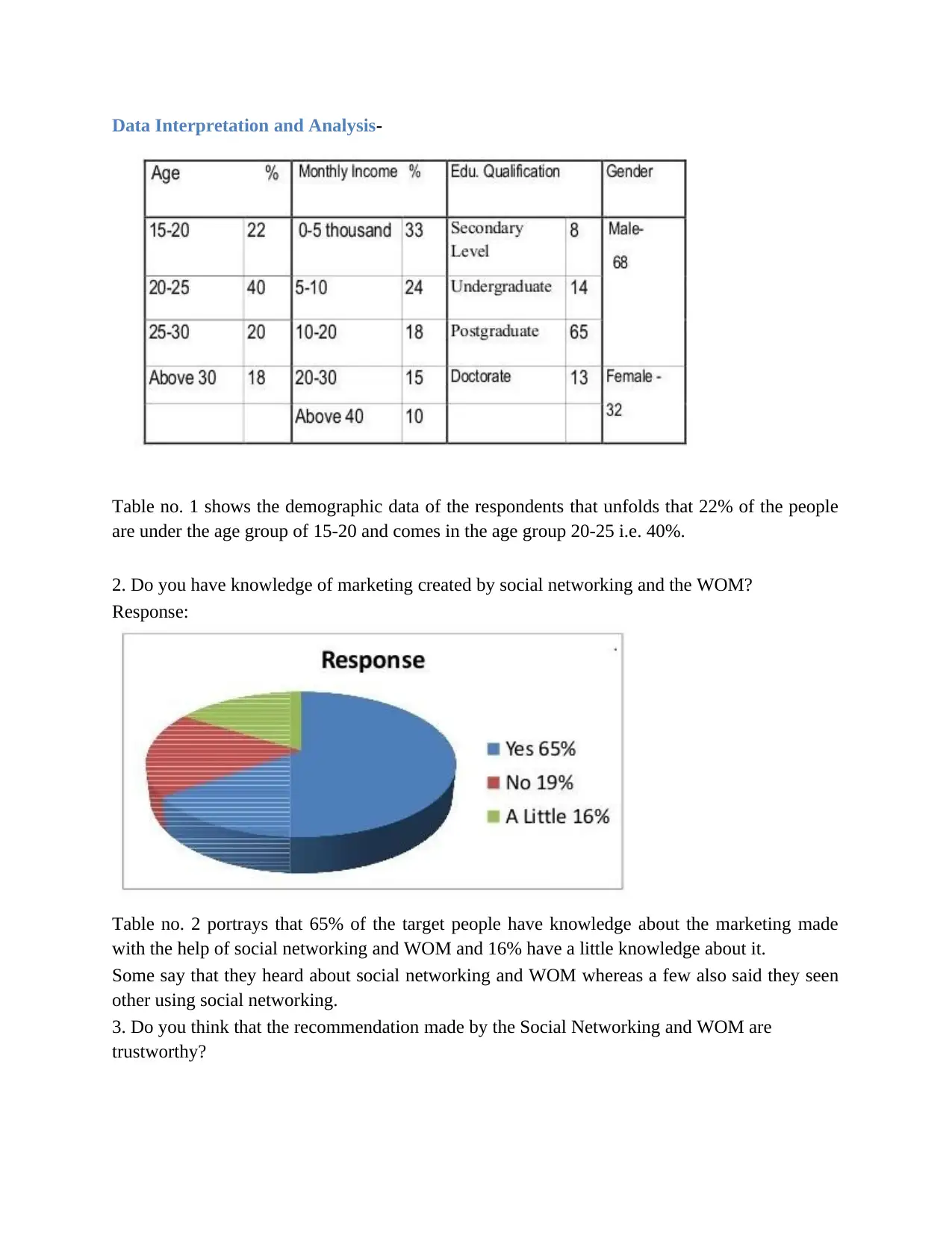
Data Interpretation and Analysis-
Table no. 1 shows the demographic data of the respondents that unfolds that 22% of the people
are under the age group of 15-20 and comes in the age group 20-25 i.e. 40%.
2. Do you have knowledge of marketing created by social networking and the WOM?
Response:
Table no. 2 portrays that 65% of the target people have knowledge about the marketing made
with the help of social networking and WOM and 16% have a little knowledge about it.
Some say that they heard about social networking and WOM whereas a few also said they seen
other using social networking.
3. Do you think that the recommendation made by the Social Networking and WOM are
trustworthy?
Table no. 1 shows the demographic data of the respondents that unfolds that 22% of the people
are under the age group of 15-20 and comes in the age group 20-25 i.e. 40%.
2. Do you have knowledge of marketing created by social networking and the WOM?
Response:
Table no. 2 portrays that 65% of the target people have knowledge about the marketing made
with the help of social networking and WOM and 16% have a little knowledge about it.
Some say that they heard about social networking and WOM whereas a few also said they seen
other using social networking.
3. Do you think that the recommendation made by the Social Networking and WOM are
trustworthy?
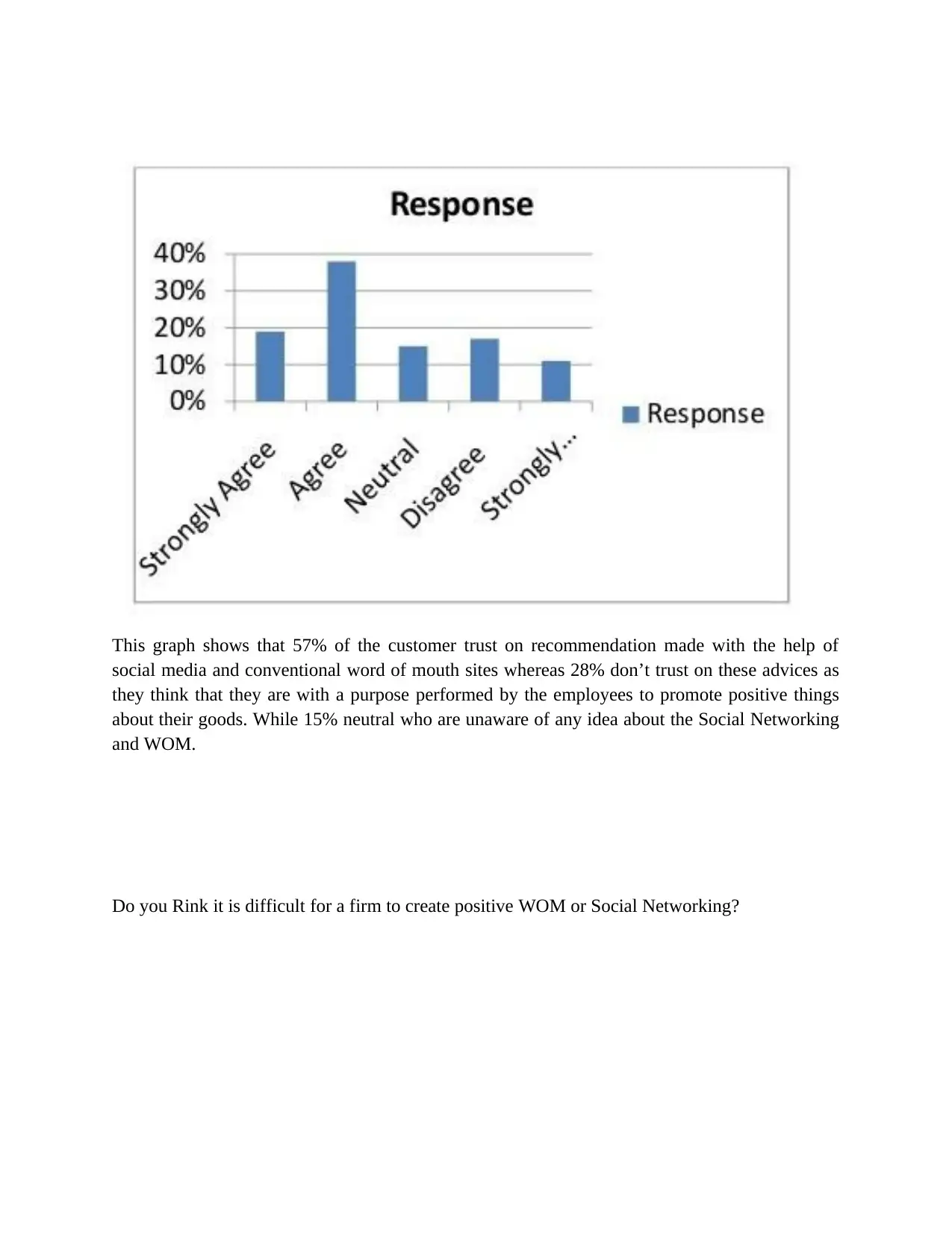
This graph shows that 57% of the customer trust on recommendation made with the help of
social media and conventional word of mouth sites whereas 28% don’t trust on these advices as
they think that they are with a purpose performed by the employees to promote positive things
about their goods. While 15% neutral who are unaware of any idea about the Social Networking
and WOM.
Do you Rink it is difficult for a firm to create positive WOM or Social Networking?
social media and conventional word of mouth sites whereas 28% don’t trust on these advices as
they think that they are with a purpose performed by the employees to promote positive things
about their goods. While 15% neutral who are unaware of any idea about the Social Networking
and WOM.
Do you Rink it is difficult for a firm to create positive WOM or Social Networking?
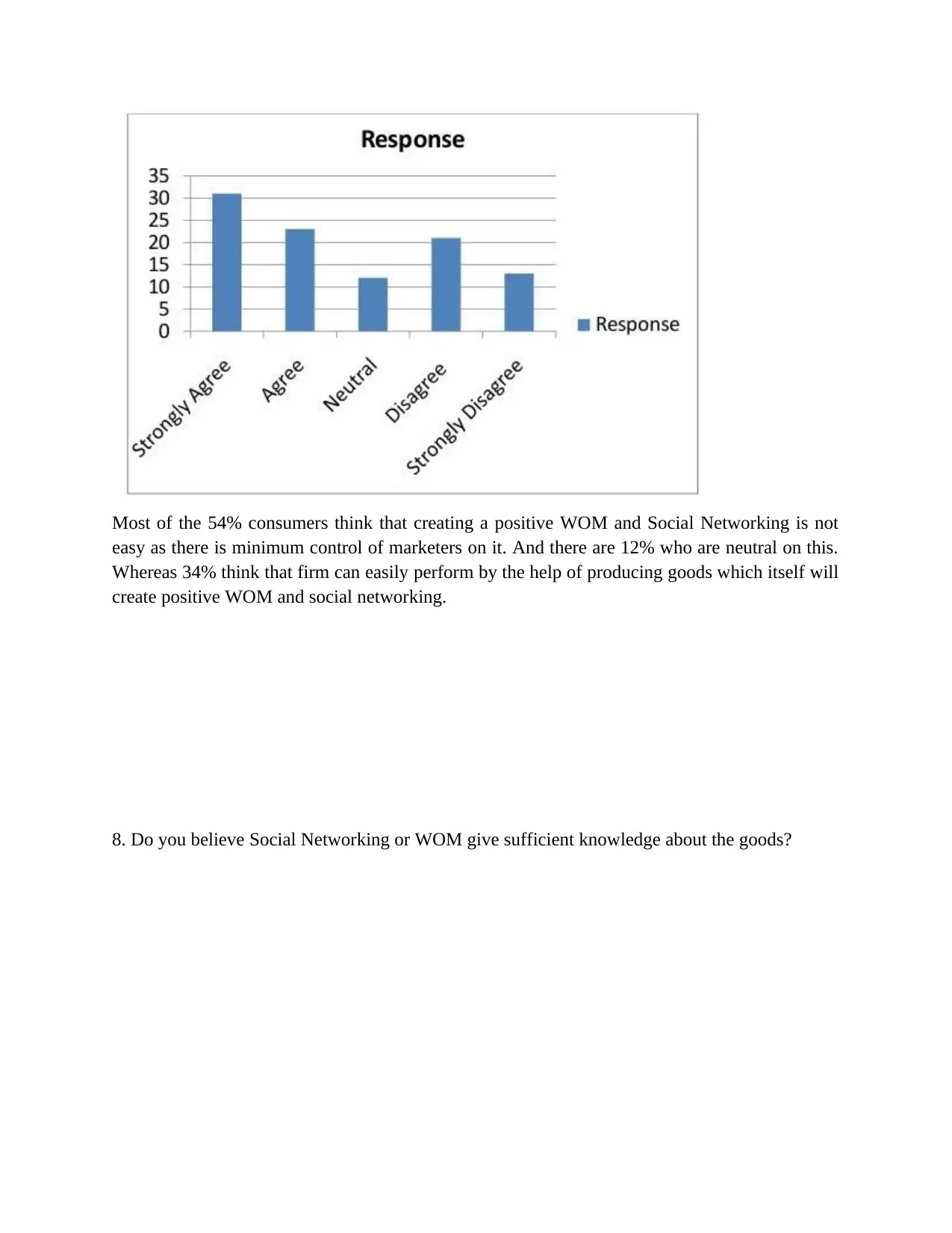
Most of the 54% consumers think that creating a positive WOM and Social Networking is not
easy as there is minimum control of marketers on it. And there are 12% who are neutral on this.
Whereas 34% think that firm can easily perform by the help of producing goods which itself will
create positive WOM and social networking.
8. Do you believe Social Networking or WOM give sufficient knowledge about the goods?
easy as there is minimum control of marketers on it. And there are 12% who are neutral on this.
Whereas 34% think that firm can easily perform by the help of producing goods which itself will
create positive WOM and social networking.
8. Do you believe Social Networking or WOM give sufficient knowledge about the goods?
Secure Best Marks with AI Grader
Need help grading? Try our AI Grader for instant feedback on your assignments.
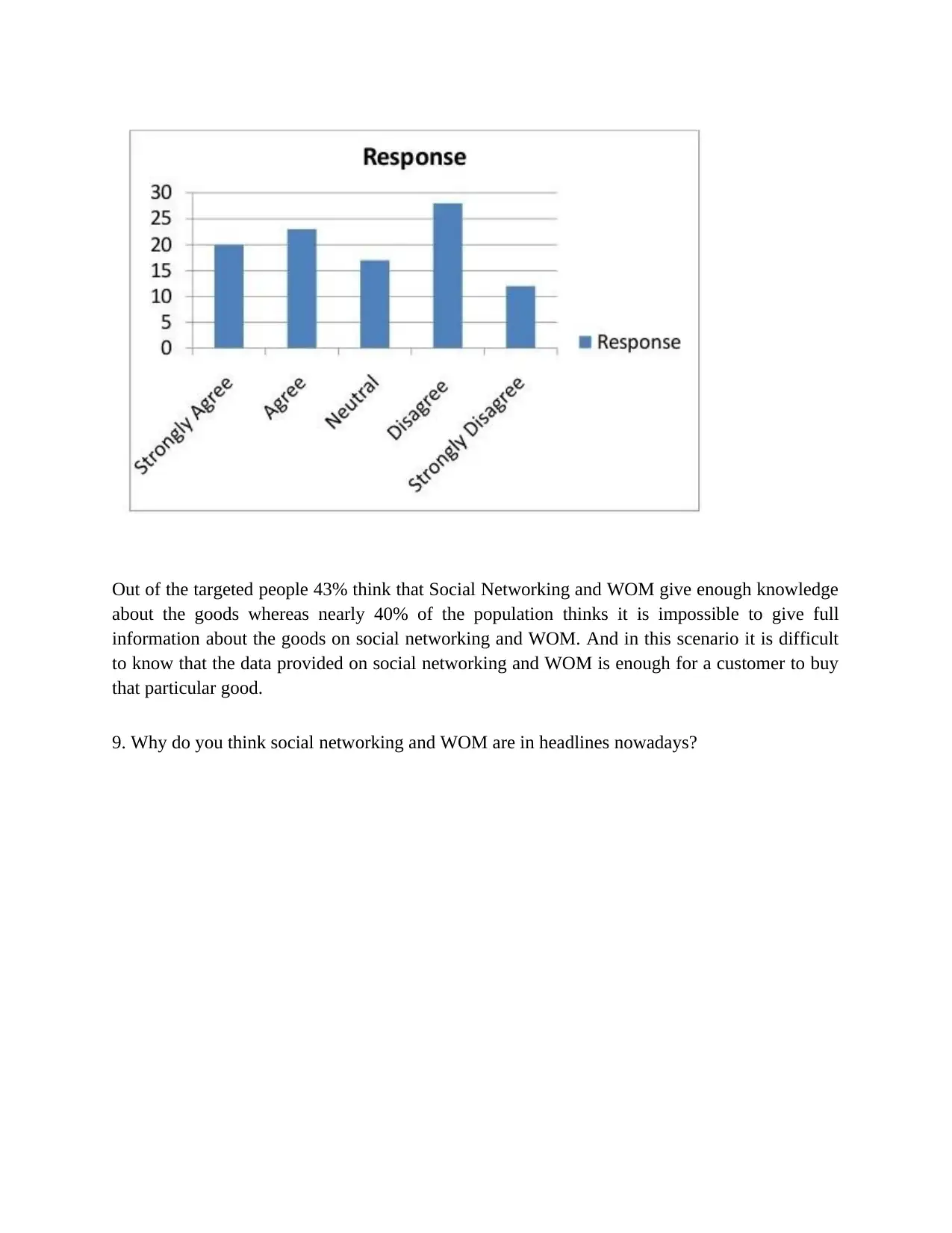
Out of the targeted people 43% think that Social Networking and WOM give enough knowledge
about the goods whereas nearly 40% of the population thinks it is impossible to give full
information about the goods on social networking and WOM. And in this scenario it is difficult
to know that the data provided on social networking and WOM is enough for a customer to buy
that particular good.
9. Why do you think social networking and WOM are in headlines nowadays?
about the goods whereas nearly 40% of the population thinks it is impossible to give full
information about the goods on social networking and WOM. And in this scenario it is difficult
to know that the data provided on social networking and WOM is enough for a customer to buy
that particular good.
9. Why do you think social networking and WOM are in headlines nowadays?
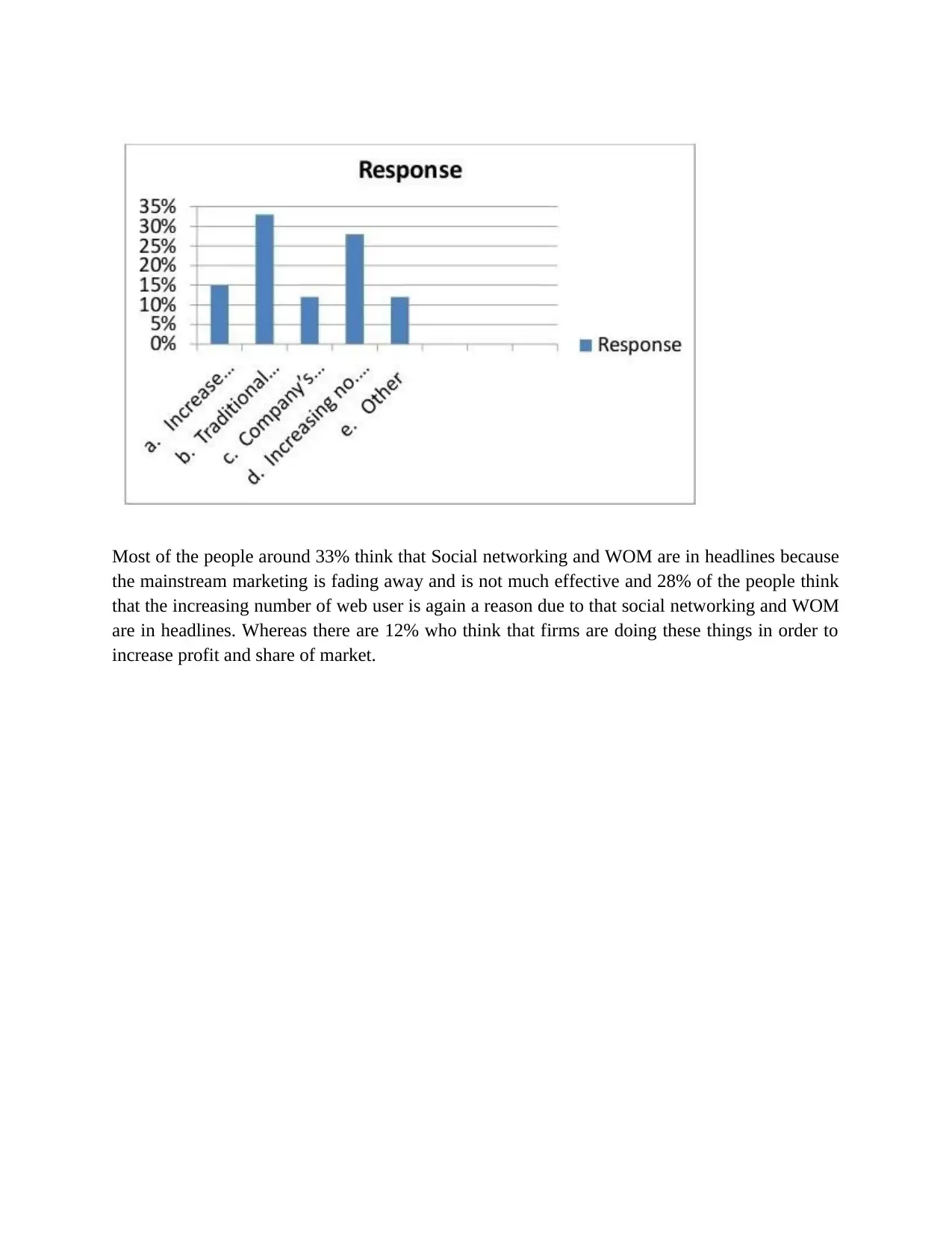
Most of the people around 33% think that Social networking and WOM are in headlines because
the mainstream marketing is fading away and is not much effective and 28% of the people think
that the increasing number of web user is again a reason due to that social networking and WOM
are in headlines. Whereas there are 12% who think that firms are doing these things in order to
increase profit and share of market.
the mainstream marketing is fading away and is not much effective and 28% of the people think
that the increasing number of web user is again a reason due to that social networking and WOM
are in headlines. Whereas there are 12% who think that firms are doing these things in order to
increase profit and share of market.
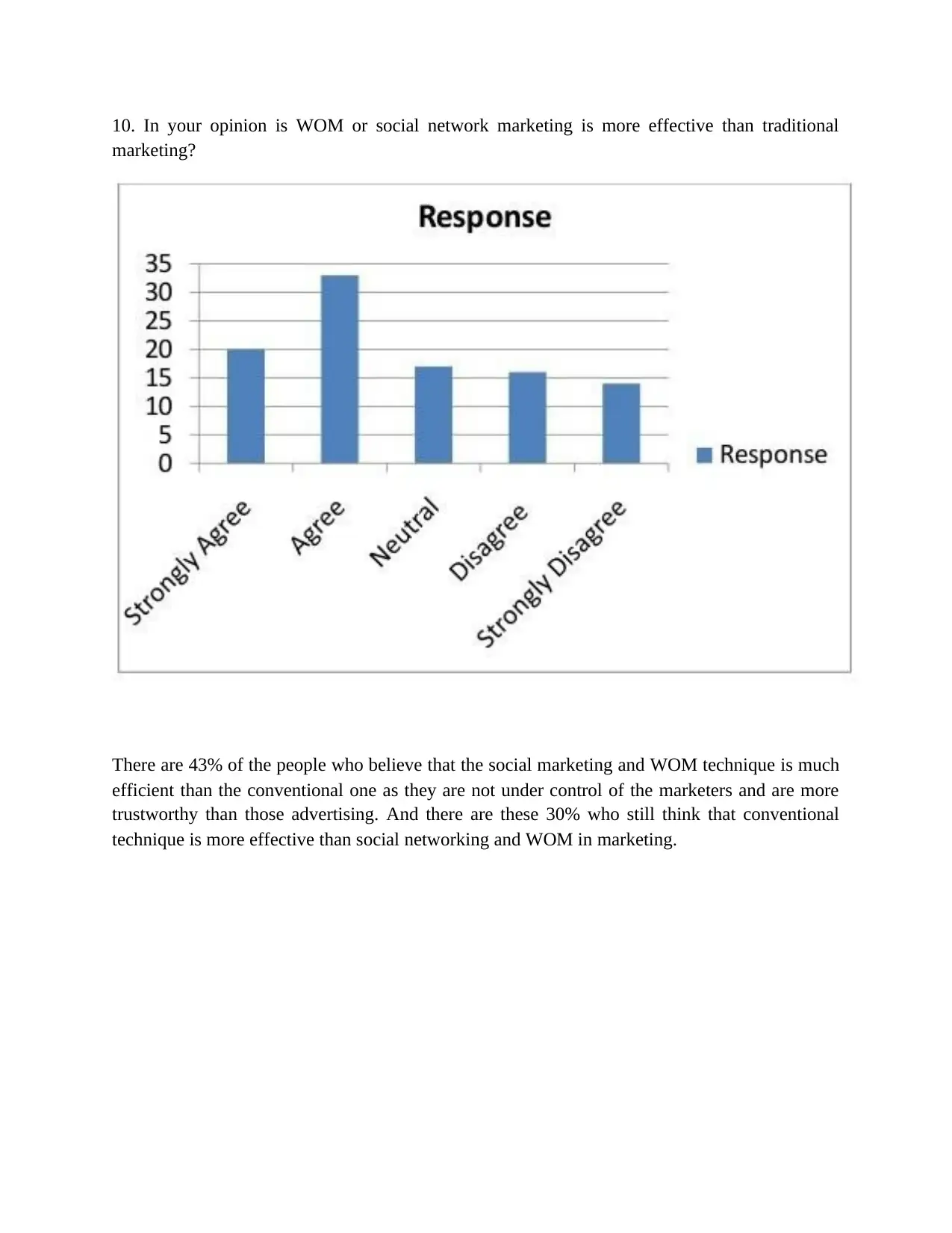
10. In your opinion is WOM or social network marketing is more effective than traditional
marketing?
There are 43% of the people who believe that the social marketing and WOM technique is much
efficient than the conventional one as they are not under control of the marketers and are more
trustworthy than those advertising. And there are these 30% who still think that conventional
technique is more effective than social networking and WOM in marketing.
marketing?
There are 43% of the people who believe that the social marketing and WOM technique is much
efficient than the conventional one as they are not under control of the marketers and are more
trustworthy than those advertising. And there are these 30% who still think that conventional
technique is more effective than social networking and WOM in marketing.
Paraphrase This Document
Need a fresh take? Get an instant paraphrase of this document with our AI Paraphraser
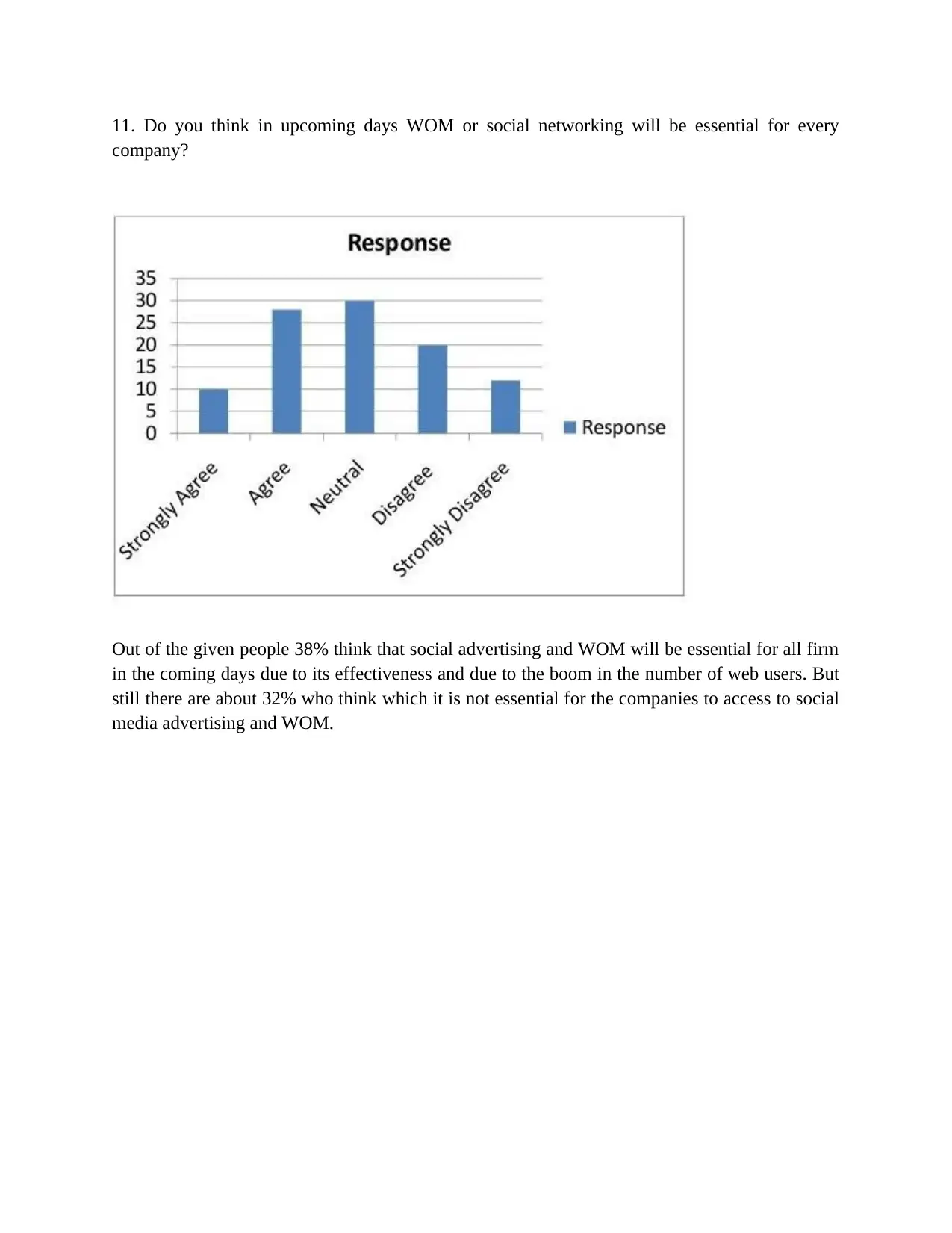
11. Do you think in upcoming days WOM or social networking will be essential for every
company?
Out of the given people 38% think that social advertising and WOM will be essential for all firm
in the coming days due to its effectiveness and due to the boom in the number of web users. But
still there are about 32% who think which it is not essential for the companies to access to social
media advertising and WOM.
company?
Out of the given people 38% think that social advertising and WOM will be essential for all firm
in the coming days due to its effectiveness and due to the boom in the number of web users. But
still there are about 32% who think which it is not essential for the companies to access to social
media advertising and WOM.
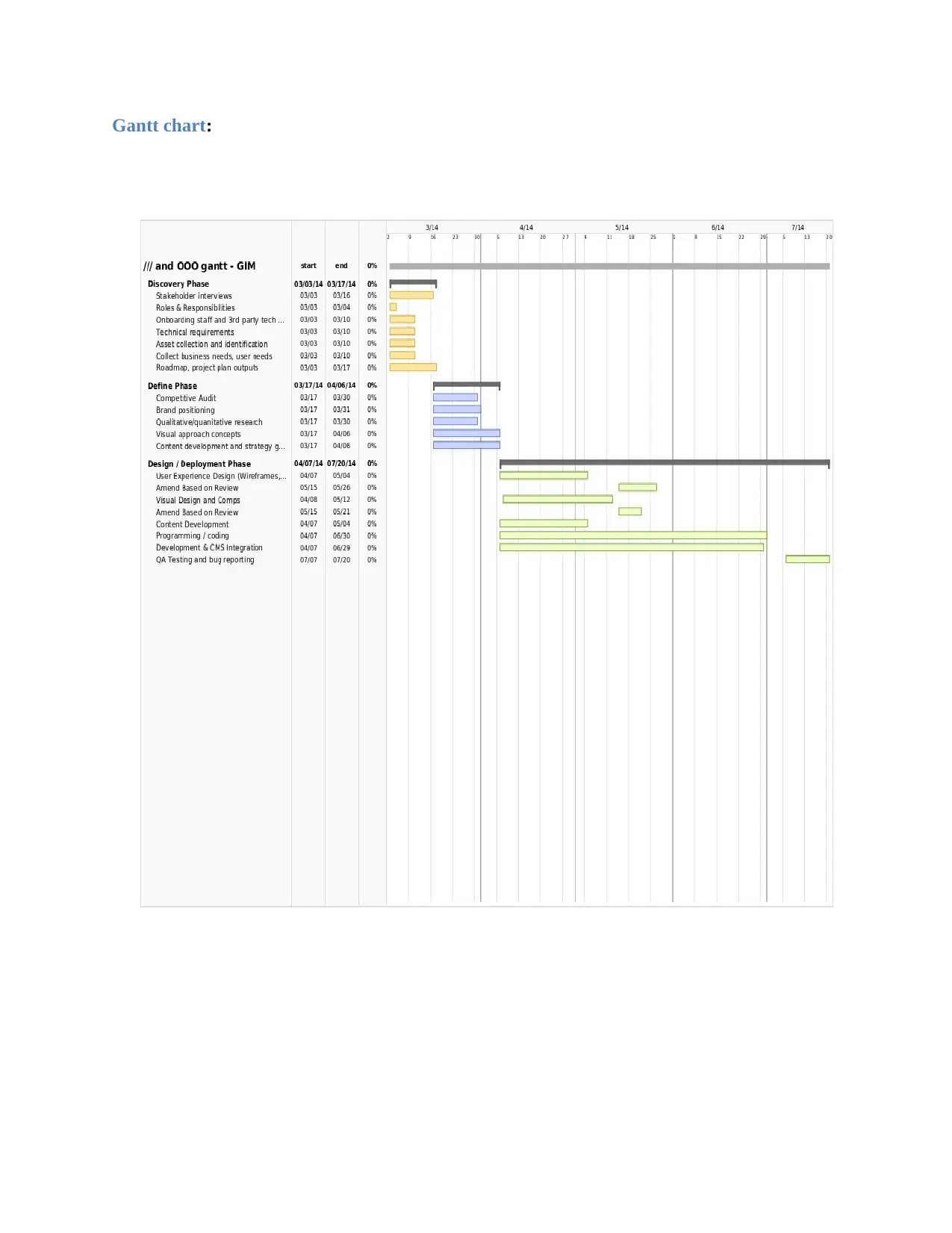
Gantt chart:
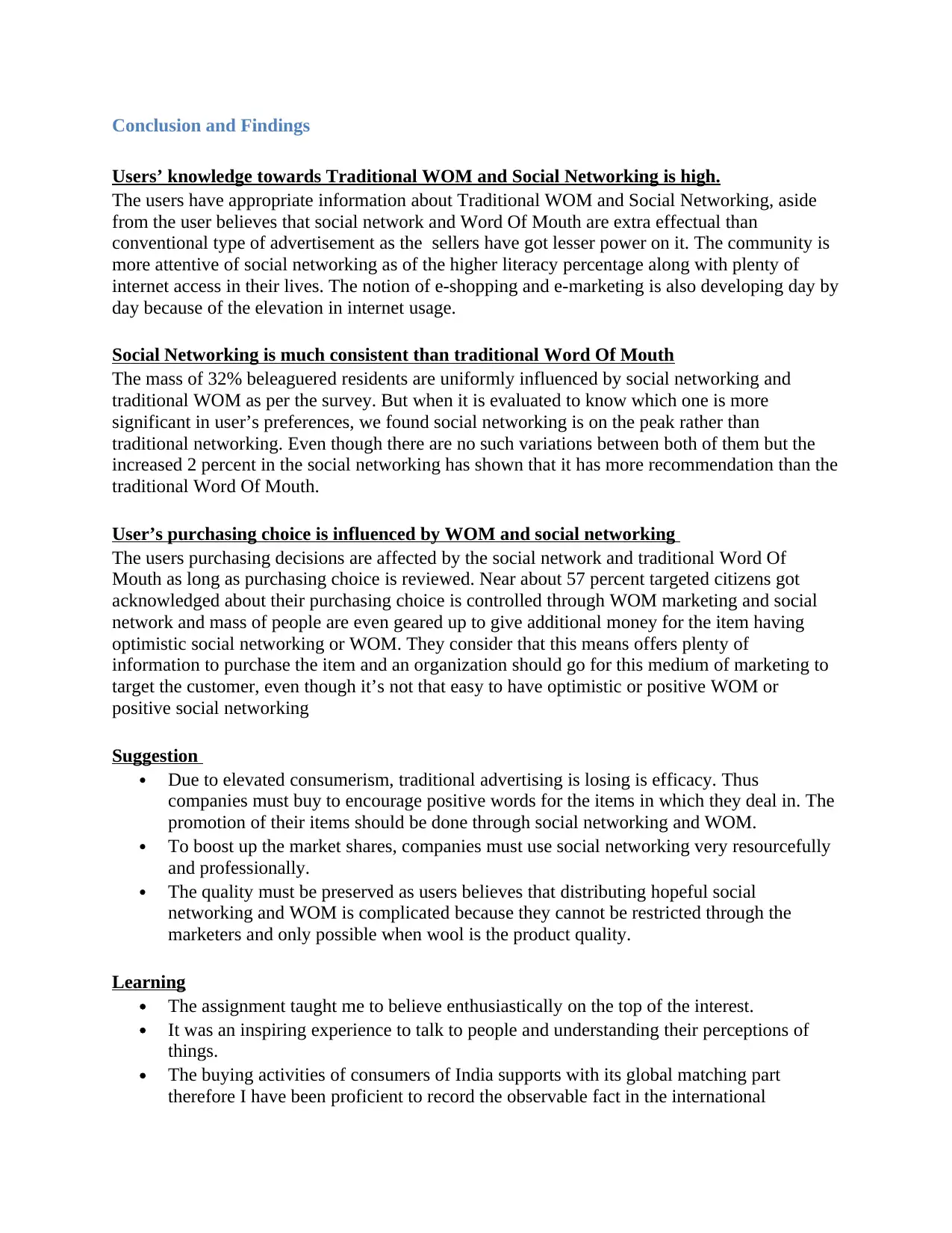
Conclusion and Findings
Users’ knowledge towards Traditional WOM and Social Networking is high.
The users have appropriate information about Traditional WOM and Social Networking, aside
from the user believes that social network and Word Of Mouth are extra effectual than
conventional type of advertisement as the sellers have got lesser power on it. The community is
more attentive of social networking as of the higher literacy percentage along with plenty of
internet access in their lives. The notion of e-shopping and e-marketing is also developing day by
day because of the elevation in internet usage.
Social Networking is much consistent than traditional Word Of Mouth
The mass of 32% beleaguered residents are uniformly influenced by social networking and
traditional WOM as per the survey. But when it is evaluated to know which one is more
significant in user’s preferences, we found social networking is on the peak rather than
traditional networking. Even though there are no such variations between both of them but the
increased 2 percent in the social networking has shown that it has more recommendation than the
traditional Word Of Mouth.
User’s purchasing choice is influenced by WOM and social networking
The users purchasing decisions are affected by the social network and traditional Word Of
Mouth as long as purchasing choice is reviewed. Near about 57 percent targeted citizens got
acknowledged about their purchasing choice is controlled through WOM marketing and social
network and mass of people are even geared up to give additional money for the item having
optimistic social networking or WOM. They consider that this means offers plenty of
information to purchase the item and an organization should go for this medium of marketing to
target the customer, even though it’s not that easy to have optimistic or positive WOM or
positive social networking
Suggestion
Due to elevated consumerism, traditional advertising is losing is efficacy. Thus
companies must buy to encourage positive words for the items in which they deal in. The
promotion of their items should be done through social networking and WOM.
To boost up the market shares, companies must use social networking very resourcefully
and professionally.
The quality must be preserved as users believes that distributing hopeful social
networking and WOM is complicated because they cannot be restricted through the
marketers and only possible when wool is the product quality.
Learning
The assignment taught me to believe enthusiastically on the top of the interest.
It was an inspiring experience to talk to people and understanding their perceptions of
things.
The buying activities of consumers of India supports with its global matching part
therefore I have been proficient to record the observable fact in the international
Users’ knowledge towards Traditional WOM and Social Networking is high.
The users have appropriate information about Traditional WOM and Social Networking, aside
from the user believes that social network and Word Of Mouth are extra effectual than
conventional type of advertisement as the sellers have got lesser power on it. The community is
more attentive of social networking as of the higher literacy percentage along with plenty of
internet access in their lives. The notion of e-shopping and e-marketing is also developing day by
day because of the elevation in internet usage.
Social Networking is much consistent than traditional Word Of Mouth
The mass of 32% beleaguered residents are uniformly influenced by social networking and
traditional WOM as per the survey. But when it is evaluated to know which one is more
significant in user’s preferences, we found social networking is on the peak rather than
traditional networking. Even though there are no such variations between both of them but the
increased 2 percent in the social networking has shown that it has more recommendation than the
traditional Word Of Mouth.
User’s purchasing choice is influenced by WOM and social networking
The users purchasing decisions are affected by the social network and traditional Word Of
Mouth as long as purchasing choice is reviewed. Near about 57 percent targeted citizens got
acknowledged about their purchasing choice is controlled through WOM marketing and social
network and mass of people are even geared up to give additional money for the item having
optimistic social networking or WOM. They consider that this means offers plenty of
information to purchase the item and an organization should go for this medium of marketing to
target the customer, even though it’s not that easy to have optimistic or positive WOM or
positive social networking
Suggestion
Due to elevated consumerism, traditional advertising is losing is efficacy. Thus
companies must buy to encourage positive words for the items in which they deal in. The
promotion of their items should be done through social networking and WOM.
To boost up the market shares, companies must use social networking very resourcefully
and professionally.
The quality must be preserved as users believes that distributing hopeful social
networking and WOM is complicated because they cannot be restricted through the
marketers and only possible when wool is the product quality.
Learning
The assignment taught me to believe enthusiastically on the top of the interest.
It was an inspiring experience to talk to people and understanding their perceptions of
things.
The buying activities of consumers of India supports with its global matching part
therefore I have been proficient to record the observable fact in the international
Secure Best Marks with AI Grader
Need help grading? Try our AI Grader for instant feedback on your assignments.
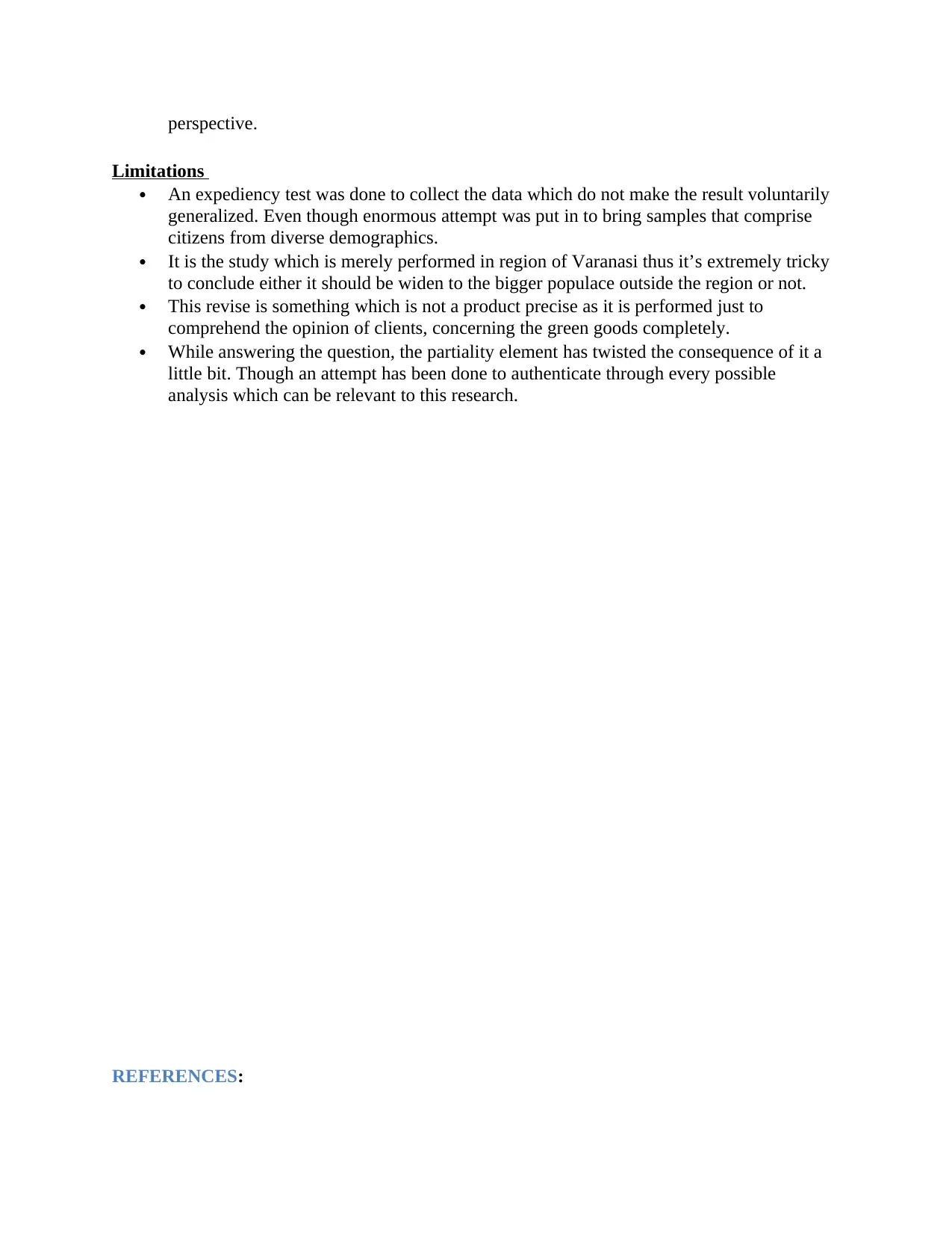
perspective.
Limitations
An expediency test was done to collect the data which do not make the result voluntarily
generalized. Even though enormous attempt was put in to bring samples that comprise
citizens from diverse demographics.
It is the study which is merely performed in region of Varanasi thus it’s extremely tricky
to conclude either it should be widen to the bigger populace outside the region or not.
This revise is something which is not a product precise as it is performed just to
comprehend the opinion of clients, concerning the green goods completely.
While answering the question, the partiality element has twisted the consequence of it a
little bit. Though an attempt has been done to authenticate through every possible
analysis which can be relevant to this research.
REFERENCES:
Limitations
An expediency test was done to collect the data which do not make the result voluntarily
generalized. Even though enormous attempt was put in to bring samples that comprise
citizens from diverse demographics.
It is the study which is merely performed in region of Varanasi thus it’s extremely tricky
to conclude either it should be widen to the bigger populace outside the region or not.
This revise is something which is not a product precise as it is performed just to
comprehend the opinion of clients, concerning the green goods completely.
While answering the question, the partiality element has twisted the consequence of it a
little bit. Though an attempt has been done to authenticate through every possible
analysis which can be relevant to this research.
REFERENCES:
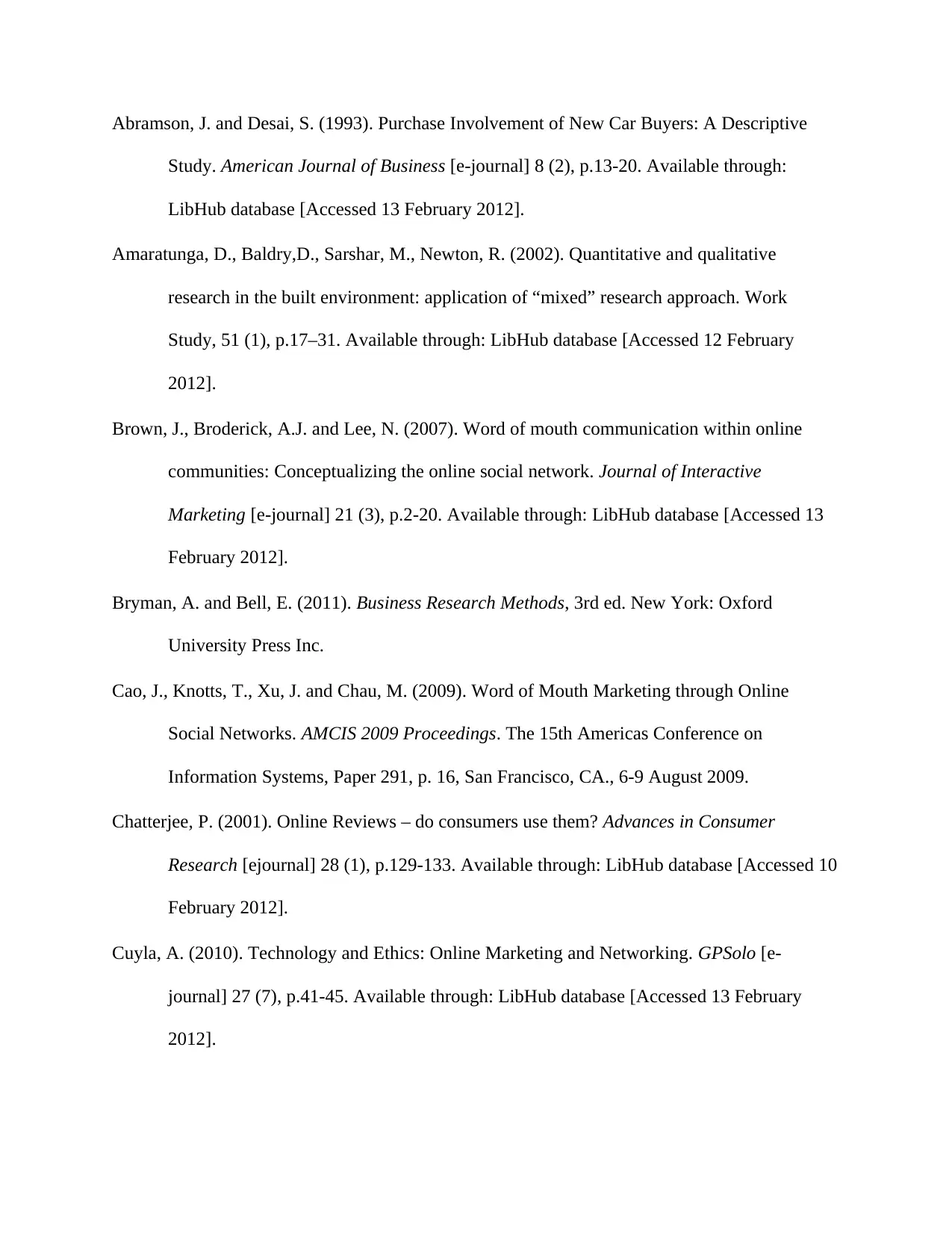
Abramson, J. and Desai, S. (1993). Purchase Involvement of New Car Buyers: A Descriptive
Study. American Journal of Business [e-journal] 8 (2), p.13-20. Available through:
LibHub database [Accessed 13 February 2012].
Amaratunga, D., Baldry,D., Sarshar, M., Newton, R. (2002). Quantitative and qualitative
research in the built environment: application of “mixed” research approach. Work
Study, 51 (1), p.17–31. Available through: LibHub database [Accessed 12 February
2012].
Brown, J., Broderick, A.J. and Lee, N. (2007). Word of mouth communication within online
communities: Conceptualizing the online social network. Journal of Interactive
Marketing [e-journal] 21 (3), p.2-20. Available through: LibHub database [Accessed 13
February 2012].
Bryman, A. and Bell, E. (2011). Business Research Methods, 3rd ed. New York: Oxford
University Press Inc.
Cao, J., Knotts, T., Xu, J. and Chau, M. (2009). Word of Mouth Marketing through Online
Social Networks. AMCIS 2009 Proceedings. The 15th Americas Conference on
Information Systems, Paper 291, p. 16, San Francisco, CA., 6-9 August 2009.
Chatterjee, P. (2001). Online Reviews – do consumers use them? Advances in Consumer
Research [ejournal] 28 (1), p.129-133. Available through: LibHub database [Accessed 10
February 2012].
Cuyla, A. (2010). Technology and Ethics: Online Marketing and Networking. GPSolo [e-
journal] 27 (7), p.41-45. Available through: LibHub database [Accessed 13 February
2012].
Study. American Journal of Business [e-journal] 8 (2), p.13-20. Available through:
LibHub database [Accessed 13 February 2012].
Amaratunga, D., Baldry,D., Sarshar, M., Newton, R. (2002). Quantitative and qualitative
research in the built environment: application of “mixed” research approach. Work
Study, 51 (1), p.17–31. Available through: LibHub database [Accessed 12 February
2012].
Brown, J., Broderick, A.J. and Lee, N. (2007). Word of mouth communication within online
communities: Conceptualizing the online social network. Journal of Interactive
Marketing [e-journal] 21 (3), p.2-20. Available through: LibHub database [Accessed 13
February 2012].
Bryman, A. and Bell, E. (2011). Business Research Methods, 3rd ed. New York: Oxford
University Press Inc.
Cao, J., Knotts, T., Xu, J. and Chau, M. (2009). Word of Mouth Marketing through Online
Social Networks. AMCIS 2009 Proceedings. The 15th Americas Conference on
Information Systems, Paper 291, p. 16, San Francisco, CA., 6-9 August 2009.
Chatterjee, P. (2001). Online Reviews – do consumers use them? Advances in Consumer
Research [ejournal] 28 (1), p.129-133. Available through: LibHub database [Accessed 10
February 2012].
Cuyla, A. (2010). Technology and Ethics: Online Marketing and Networking. GPSolo [e-
journal] 27 (7), p.41-45. Available through: LibHub database [Accessed 13 February
2012].
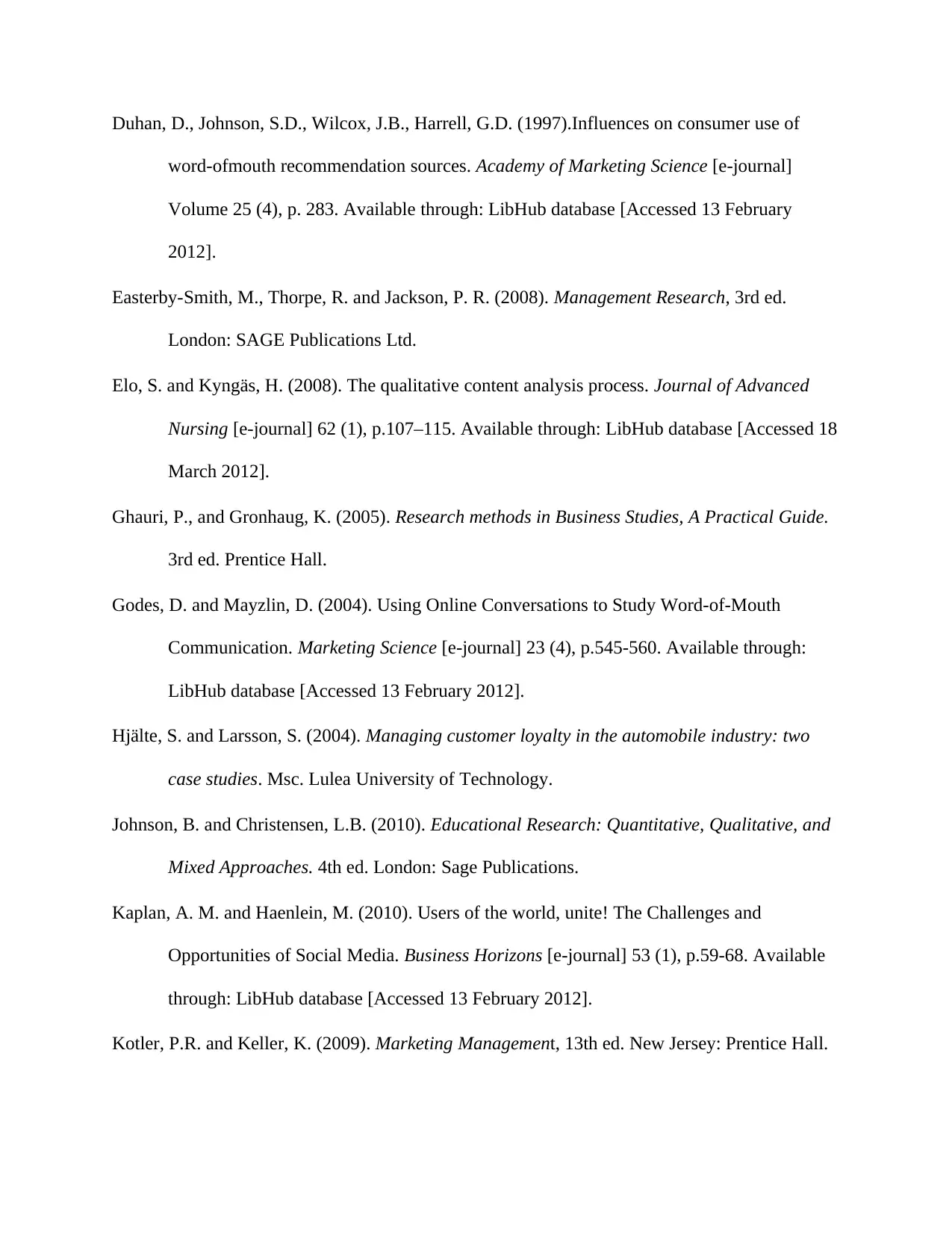
Duhan, D., Johnson, S.D., Wilcox, J.B., Harrell, G.D. (1997).Influences on consumer use of
word-ofmouth recommendation sources. Academy of Marketing Science [e-journal]
Volume 25 (4), p. 283. Available through: LibHub database [Accessed 13 February
2012].
Easterby-Smith, M., Thorpe, R. and Jackson, P. R. (2008). Management Research, 3rd ed.
London: SAGE Publications Ltd.
Elo, S. and Kyngäs, H. (2008). The qualitative content analysis process. Journal of Advanced
Nursing [e-journal] 62 (1), p.107–115. Available through: LibHub database [Accessed 18
March 2012].
Ghauri, P., and Gronhaug, K. (2005). Research methods in Business Studies, A Practical Guide.
3rd ed. Prentice Hall.
Godes, D. and Mayzlin, D. (2004). Using Online Conversations to Study Word-of-Mouth
Communication. Marketing Science [e-journal] 23 (4), p.545-560. Available through:
LibHub database [Accessed 13 February 2012].
Hjälte, S. and Larsson, S. (2004). Managing customer loyalty in the automobile industry: two
case studies. Msc. Lulea University of Technology.
Johnson, B. and Christensen, L.B. (2010). Educational Research: Quantitative, Qualitative, and
Mixed Approaches. 4th ed. London: Sage Publications.
Kaplan, A. M. and Haenlein, M. (2010). Users of the world, unite! The Challenges and
Opportunities of Social Media. Business Horizons [e-journal] 53 (1), p.59-68. Available
through: LibHub database [Accessed 13 February 2012].
Kotler, P.R. and Keller, K. (2009). Marketing Management, 13th ed. New Jersey: Prentice Hall.
word-ofmouth recommendation sources. Academy of Marketing Science [e-journal]
Volume 25 (4), p. 283. Available through: LibHub database [Accessed 13 February
2012].
Easterby-Smith, M., Thorpe, R. and Jackson, P. R. (2008). Management Research, 3rd ed.
London: SAGE Publications Ltd.
Elo, S. and Kyngäs, H. (2008). The qualitative content analysis process. Journal of Advanced
Nursing [e-journal] 62 (1), p.107–115. Available through: LibHub database [Accessed 18
March 2012].
Ghauri, P., and Gronhaug, K. (2005). Research methods in Business Studies, A Practical Guide.
3rd ed. Prentice Hall.
Godes, D. and Mayzlin, D. (2004). Using Online Conversations to Study Word-of-Mouth
Communication. Marketing Science [e-journal] 23 (4), p.545-560. Available through:
LibHub database [Accessed 13 February 2012].
Hjälte, S. and Larsson, S. (2004). Managing customer loyalty in the automobile industry: two
case studies. Msc. Lulea University of Technology.
Johnson, B. and Christensen, L.B. (2010). Educational Research: Quantitative, Qualitative, and
Mixed Approaches. 4th ed. London: Sage Publications.
Kaplan, A. M. and Haenlein, M. (2010). Users of the world, unite! The Challenges and
Opportunities of Social Media. Business Horizons [e-journal] 53 (1), p.59-68. Available
through: LibHub database [Accessed 13 February 2012].
Kotler, P.R. and Keller, K. (2009). Marketing Management, 13th ed. New Jersey: Prentice Hall.
Paraphrase This Document
Need a fresh take? Get an instant paraphrase of this document with our AI Paraphraser
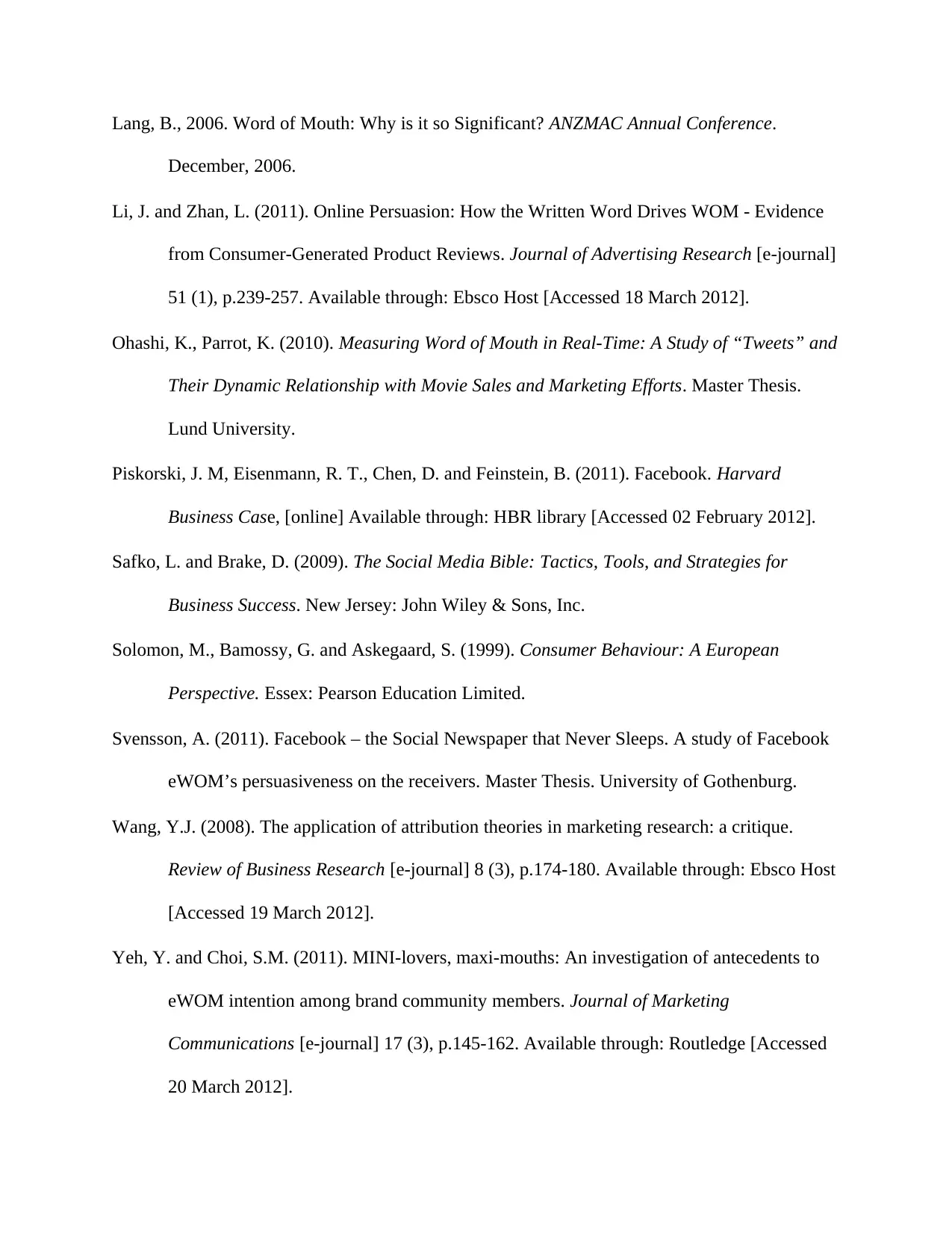
Lang, B., 2006. Word of Mouth: Why is it so Significant? ANZMAC Annual Conference.
December, 2006.
Li, J. and Zhan, L. (2011). Online Persuasion: How the Written Word Drives WOM - Evidence
from Consumer-Generated Product Reviews. Journal of Advertising Research [e-journal]
51 (1), p.239-257. Available through: Ebsco Host [Accessed 18 March 2012].
Ohashi, K., Parrot, K. (2010). Measuring Word of Mouth in Real-Time: A Study of “Tweets” and
Their Dynamic Relationship with Movie Sales and Marketing Efforts. Master Thesis.
Lund University.
Piskorski, J. M, Eisenmann, R. T., Chen, D. and Feinstein, B. (2011). Facebook. Harvard
Business Case, [online] Available through: HBR library [Accessed 02 February 2012].
Safko, L. and Brake, D. (2009). The Social Media Bible: Tactics, Tools, and Strategies for
Business Success. New Jersey: John Wiley & Sons, Inc.
Solomon, M., Bamossy, G. and Askegaard, S. (1999). Consumer Behaviour: A European
Perspective. Essex: Pearson Education Limited.
Svensson, A. (2011). Facebook – the Social Newspaper that Never Sleeps. A study of Facebook
eWOM’s persuasiveness on the receivers. Master Thesis. University of Gothenburg.
Wang, Y.J. (2008). The application of attribution theories in marketing research: a critique.
Review of Business Research [e-journal] 8 (3), p.174-180. Available through: Ebsco Host
[Accessed 19 March 2012].
Yeh, Y. and Choi, S.M. (2011). MINI-lovers, maxi-mouths: An investigation of antecedents to
eWOM intention among brand community members. Journal of Marketing
Communications [e-journal] 17 (3), p.145-162. Available through: Routledge [Accessed
20 March 2012].
December, 2006.
Li, J. and Zhan, L. (2011). Online Persuasion: How the Written Word Drives WOM - Evidence
from Consumer-Generated Product Reviews. Journal of Advertising Research [e-journal]
51 (1), p.239-257. Available through: Ebsco Host [Accessed 18 March 2012].
Ohashi, K., Parrot, K. (2010). Measuring Word of Mouth in Real-Time: A Study of “Tweets” and
Their Dynamic Relationship with Movie Sales and Marketing Efforts. Master Thesis.
Lund University.
Piskorski, J. M, Eisenmann, R. T., Chen, D. and Feinstein, B. (2011). Facebook. Harvard
Business Case, [online] Available through: HBR library [Accessed 02 February 2012].
Safko, L. and Brake, D. (2009). The Social Media Bible: Tactics, Tools, and Strategies for
Business Success. New Jersey: John Wiley & Sons, Inc.
Solomon, M., Bamossy, G. and Askegaard, S. (1999). Consumer Behaviour: A European
Perspective. Essex: Pearson Education Limited.
Svensson, A. (2011). Facebook – the Social Newspaper that Never Sleeps. A study of Facebook
eWOM’s persuasiveness on the receivers. Master Thesis. University of Gothenburg.
Wang, Y.J. (2008). The application of attribution theories in marketing research: a critique.
Review of Business Research [e-journal] 8 (3), p.174-180. Available through: Ebsco Host
[Accessed 19 March 2012].
Yeh, Y. and Choi, S.M. (2011). MINI-lovers, maxi-mouths: An investigation of antecedents to
eWOM intention among brand community members. Journal of Marketing
Communications [e-journal] 17 (3), p.145-162. Available through: Routledge [Accessed
20 March 2012].

1 out of 21
Related Documents
Your All-in-One AI-Powered Toolkit for Academic Success.
+13062052269
info@desklib.com
Available 24*7 on WhatsApp / Email
![[object Object]](/_next/static/media/star-bottom.7253800d.svg)
Unlock your academic potential
© 2024 | Zucol Services PVT LTD | All rights reserved.


